 | –≠–ª–µ–∫—Ç—Ä–æ–Ω–Ω—ã–π –∫–æ–º–ø–æ–Ω–µ–Ω—Ç: EM73982 | –°–∫–∞—á–∞—Ç—å:  PDF PDF  ZIP ZIP |

1
* This specification are subject to be changed without notice.
EM73982
EM73982
EM73982
EM73982
EM73982
4-BIT MICROCONTROLLER
4-BIT MICROCONTROLLER
4-BIT MICROCONTROLLER
4-BIT MICROCONTROLLER
4-BIT MICROCONTROLLER
11.30.2001
GENERAL DESCRIPTION
GENERAL DESCRIPTION
GENERAL DESCRIPTION
GENERAL DESCRIPTION
GENERAL DESCRIPTION
EM73982 is an advanced single chip CMOS 4-bit micro-controller. It contains 16K-byte ROM, 372-nibble
RAM, 4-bit ALU, 13-level subroutine nesting, 22-stage time base, two 12-bit timer/counters for the kernal
function. EM73982 also contains 5 interrupt sources, 3 I/O ports (including 1 input port and 2 bidirection ports),
LCD display (40x8), built-in sound generator and speech synthesizer.
Except low-power consumption and high speed, EM73982 also have a sleep mode for power saving function.
EM73982 is suitable for appliaction in many fields, for example : family appliance, consumer products, hand
held games and the toy controller ... etc.
FEATURES
FEATURES
FEATURES
FEATURES
FEATURES
∑ Operation voltage
: 2.4V to 5.5V.
∑ Clock source
: Single clock system for both RC and Crystal are available by mask option.
External clock and internal clock are available by mask option.
∑ Oscillation frequency : 480K, 1M, 2M and 4M Hz are available by mask option.
∑ Instruction set
: 109 powerful instructions.
∑ Instruction cycle time : Up to 2us for 4 MHz.
∑ ROM capacity
: 16384 X 8 bits.
∑ RAM capacity
: 372 X 4 bits.
∑ Input port
: 1 port (P0.0-P0.3) and sleep/hold releasing function are available by mask option.
(each input pin is pull-up and pull-down resistor available by mask option).
∑ Bidirection port
: 2 ports (P4, P8). P4.0 and SOUND is available by mask option. P8(0..3) and sleep/
hold releasing function are available by mask option.
∑ 12-bit timer/counter
: Two 12-bit timer/counters are programmable for timer, event counter and pulse width
measurement.
∑ Built-in time base counter : 22 stages.
∑ Subroutine nesting
: Up to 13 levels.
∑ Interrupt
: External . . . . . 1 input interrupt sources.
Internal . . . . . . 2 Timer overflow interrupts.
1 Time base interrupt.
1 Speech ending interrupt.
∑ LCD driver
: 40 X 8 dots, 1/8 duty, LCD bias is 1/4 and modified 1/4 available by mask option, LCD
bias resistor is 20K X 5 and 10K X 5 available by mask option.
∑ Sound effect
: Tone generator, random generator and volume control.
∑ Speech synthesizer
: Speech data ROM . . 24K bytes.
Sample rate . . . . . . . 4K, 5K, 8K, 10K, 12K, 15K, 20K programmable.
∑ Power saving function : Sleep mode and Hold mode.
∑ Package type :
EM73982H
Chip form
68 pins.

2
* This specification are subject to be changed without notice.
EM73982
EM73982
EM73982
EM73982
EM73982
4-BIT MICROCONTROLLER
4-BIT MICROCONTROLLER
4-BIT MICROCONTROLLER
4-BIT MICROCONTROLLER
4-BIT MICROCONTROLLER
11.30.2001
FUNCTION BLOCK DIAGRAM
FUNCTION BLOCK DIAGRAM
FUNCTION BLOCK DIAGRAM
FUNCTION BLOCK DIAGRAM
FUNCTION BLOCK DIAGRAM
PIN DESCRIPTIONS
PIN DESCRIPTIONS
PIN DESCRIPTIONS
PIN DESCRIPTIONS
PIN DESCRIPTIONS
Symbol
Symbol
Symbol
Symbol
Symbol
Pin-type
Pin-type
Pin-type
Pin-type
Pin-type
Function
Function
Function
Function
Function
V
DD
Power supply (+)
V
SS
Power supply (-)
RESET
RESET-A
System reset input signal, low active
mask option :
none
pull-up
XIN/CLK
OSC-A/OSC-C Crystal/RC or external clock source connecting pin
XOUT/NC
OSC-A/OSC-C Crystal connecting pin
P0.(0..3)/WAKEUP0..3
INPUT-B
4-bit input port with Sleep/Hold releasing function
mask option :
wakeup enable, pull-up
wakeup enable, none
wakeup disable, pull-up
wakeup disable, pull-down
wakeup disable, none
P4.0/SOUND
I/O-O
1-bit bidirection I/O port or inverse sound effect output
mask option :
SOUND enable, push-pull, high current PMOS
SOUND disable, open-drain
SOUND disable, push-pull, high current PMOS
SOUND disable, push-pull, low current PMOS
P4(1..3)
I/O-N
3-bit bidirection I/O port with high current source.
mask option :
open-drain
push-pull, high current PMOS
push-pull, low current PMOS
P8.0/WAKEUPA
I/O-L
2-bit bidirection I/O port with external interrupt sources input only for
P8.2(INT0)/WAKEUPC
P8.2 and Sleep/Hold releasing function
mask option :
wakeup enable, push-pull
wakeup disable, push-pull
wakeup disable, open-drain
Interrupt
Control
Time
Base
Timer/Counter
(TA,TB)
System Control
Instruction Decoder
Instruction Register
ROM
PC
Data Bus
Reset
Control
Clock
Generator
Timing
Generator
Sleep Mode
Control
Data pointer
ACC
ALU
Flag
Z
C
S
Stack pointer
Stack
ROM
HR
LR
I/O Control
P0.0/WAKEUP0
P0.1/WAKEUP1
P0.2/WAKEUP2
P0.3/WAKEUP3
P4.0/SOUND
P4.1
P4.2
P4.3
P8.0/WAKEUPA
P8.1(TRGB)/WAKEUPB
P8.2(INT0)/WAKEUPC
P8.3(TRGA)/WAKEUPD
RESET
XIN/CLK XOUT/NC
SOUND GEN.
LCD Driver
COM0~COM7
SOUND
SEG0~SEG39
Voice
Synthesizer
VO

3
* This specification are subject to be changed without notice.
EM73982
EM73982
EM73982
EM73982
EM73982
4-BIT MICROCONTROLLER
4-BIT MICROCONTROLLER
4-BIT MICROCONTROLLER
4-BIT MICROCONTROLLER
4-BIT MICROCONTROLLER
11.30.2001
FUNCTION DESCRIPTIONS
FUNCTION DESCRIPTIONS
FUNCTION DESCRIPTIONS
FUNCTION DESCRIPTIONS
FUNCTION DESCRIPTIONS
P8.1(TRGB)/WAKEUPB I/O-L
2-bit bidirection I/O port with time/counter A,B external input and Sleep
P8.3(TRGA)/WAKEUPD
/Hold releasing function
mask option :
wakeup enable, push-pull
wakeup disable, push-pull
wakeup disable, open-drain
VO
Built-in Speech synthesizer analog signal output
SOUND
Built-in sound effect output
COM0~COM7
LCD common output pins
SEG0~SEG39
LCD segment output pins
TEST
Test pin must be floating
Symbol
Symbol
Symbol
Symbol
Symbol
Pin-type
Pin-type
Pin-type
Pin-type
Pin-type
Function
Function
Function
Function
Function
ACCUMULATOR
ACCUMULATOR
ACCUMULATOR
ACCUMULATOR
ACCUMULATOR
Accumulator is a 4-bit data register for temporary data. For the arithematic, logic and comparative opertion
.., ACC plays a role which holds the source data and result.
FLAGS
FLAGS
FLAGS
FLAGS
FLAGS
There are three kinds of flag, CF (Carry flag), ZF (Zero flag), SF (Status flag), these 3 1-bit flags are affected
by the arithematic, logic and comparative .... operation.
All flags will be put into stack when an interrupt subroutine is served, and the flags will be restored after
RTI instruction executed.
(1) Carry Flag ( CF )
The carry flag is affected by following operation:
a. Addition : CF as a carry out indicator, when the addition operation has a carry-out, CF will be "1",
in another word, if the operation has no carry-out, CF will be "0".
b. Subtraction : CF as a borrow-in indicator, when the subtraction operation must has a borrow, in the CF
will be "0", in another word, if no borrow-in, CF will be "1".
c. Comparision: CF is as a borrow-in indicator for Comparision operation as the same as subtraction
operation.
d. Rotation: CF shifts into the empty bit of accumulator for the rotation and holds the shift out data after
rotation.
e. CF test instruction : For TFCFC instruction, the content of CF sends into SF then clear itself "0".
For TTSFC instruction, the content of CF sends into SF then set itself "1".
(2) Zero Flag ( ZF )
ZF is affected by the result of ALU, if the ALU operation generate a "0" result, the ZF will be "1",
otherwise, the ZF will be "0".
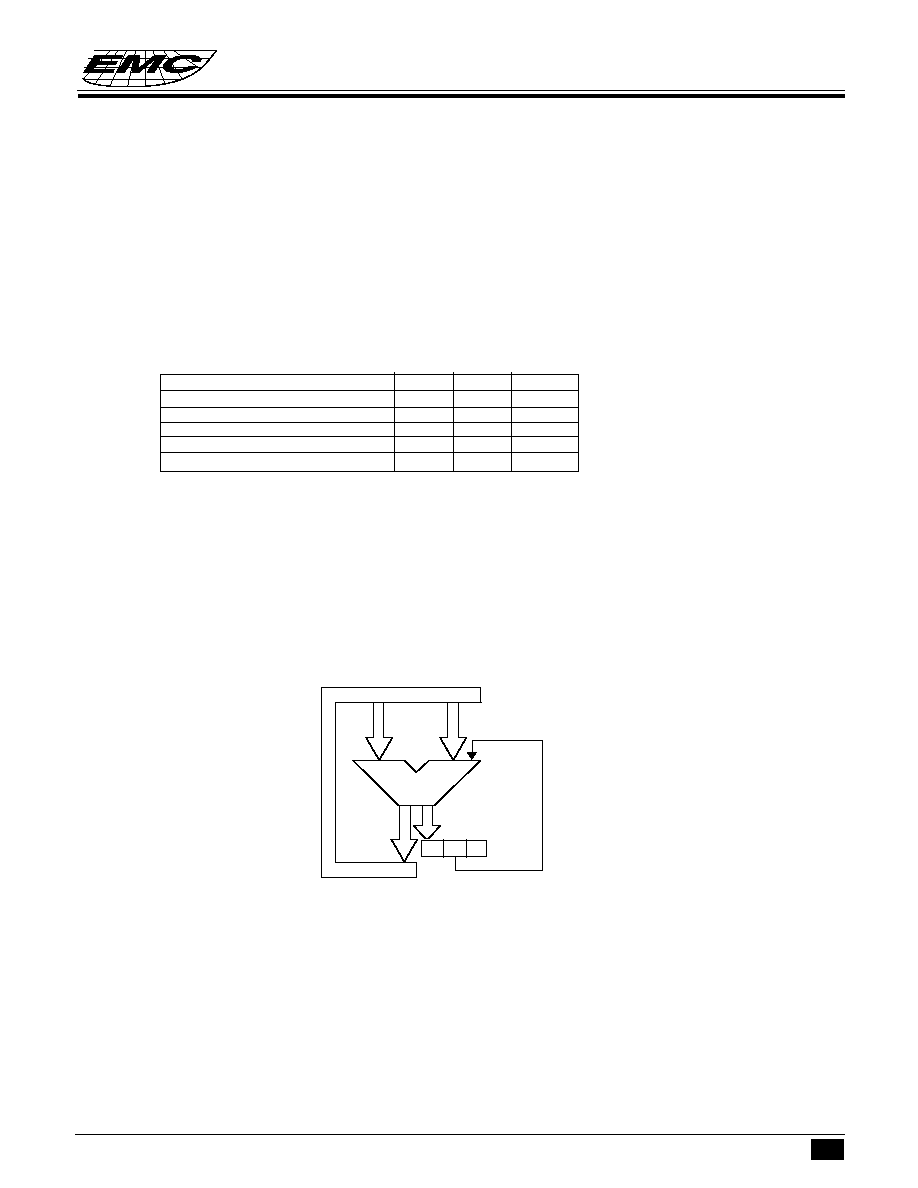
4
* This specification are subject to be changed without notice.
EM73982
EM73982
EM73982
EM73982
EM73982
4-BIT MICROCONTROLLER
4-BIT MICROCONTROLLER
4-BIT MICROCONTROLLER
4-BIT MICROCONTROLLER
4-BIT MICROCONTROLLER
11.30.2001
ZF CF SF
ALU
DATA BUS
(3) Status Flag ( SF )
The SF is affected by instruction operation and system status.
a. SF is initiated to "1" for reset condition.
b. Branch instruction is decided by SF, when SF=1, branch condition will be satisified, otherwise,
branch condition will not be satisified by SF = 0.
PROGRAM EXAMPLE:
Check following arithematic operation for CF, ZF, SF
CF
ZF
SF
LDIA #00h;
-
1
1
LDIA #03h;
-
0
1
ADDA #05h;
-
0
1
ADDA #0Dh;
-
0
0
ADDA #0Eh;
-
0
0
ALU
ALU
ALU
ALU
ALU
The arithematic operation of 4 - bit data is performed in ALU unit. There are 2 flags can be affected by
the result of ALU operation, ZF and SF. The operation of ALU can be affected by CF only.
ALU STRUCTURE
ALU STRUCTURE
ALU STRUCTURE
ALU STRUCTURE
ALU STRUCTURE
ALU supported user arithematic operation function, including : addition, subtraction and rotaion.
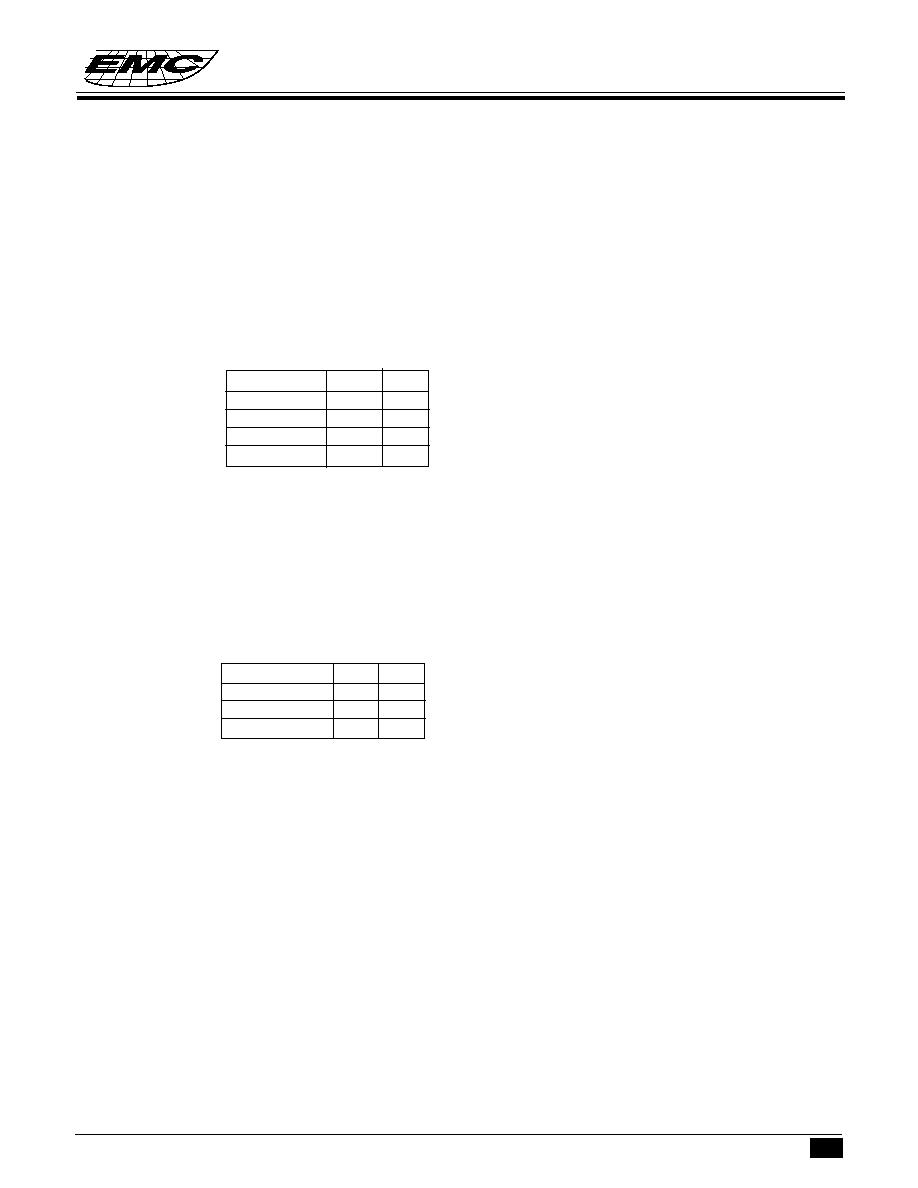
5
* This specification are subject to be changed without notice.
EM73982
EM73982
EM73982
EM73982
EM73982
4-BIT MICROCONTROLLER
4-BIT MICROCONTROLLER
4-BIT MICROCONTROLLER
4-BIT MICROCONTROLLER
4-BIT MICROCONTROLLER
11.30.2001
ALU FUNCTION
ALU FUNCTION
ALU FUNCTION
ALU FUNCTION
ALU FUNCTION
(1) Addition:
For instruction ADDAM, ADCAM, ADDM #k, ADD #k,y .... ALU supports addition function.
The addition operation can affect CF and ZF. For addition operation, if the result is "0", ZF will be "1",
otherwise, not equal "0", ZF will be "0". When the addition operation has a carry-out, CF will be "1",
otherwise, CF will be "0".
EXAMPLE:
Operation
Carry
Zero
3+4=7
0
0
7+F=6
1
0
0+0=0
0
1
8+8=0
1
1
(2) Subtraction:
For instruction SUBM #k, SUBA #k, SBCAM, DECM... ALU supports user subtraction function. The
subtraction operation can affect CF and ZF, For subtraction operation, if the result is negative, CF will
be "0", it means a borrow out, otherwise, if the result is positive, CF will be "1". For ZF, if the result
of subtraction operation is "0", the ZF will be "1", otherwise, ZF will be "1".
EXAMPLE:
Operation
Carry
Zero
8-4=4
1
0
7-F= -8(1000)
0
0
9-9=0
1
1
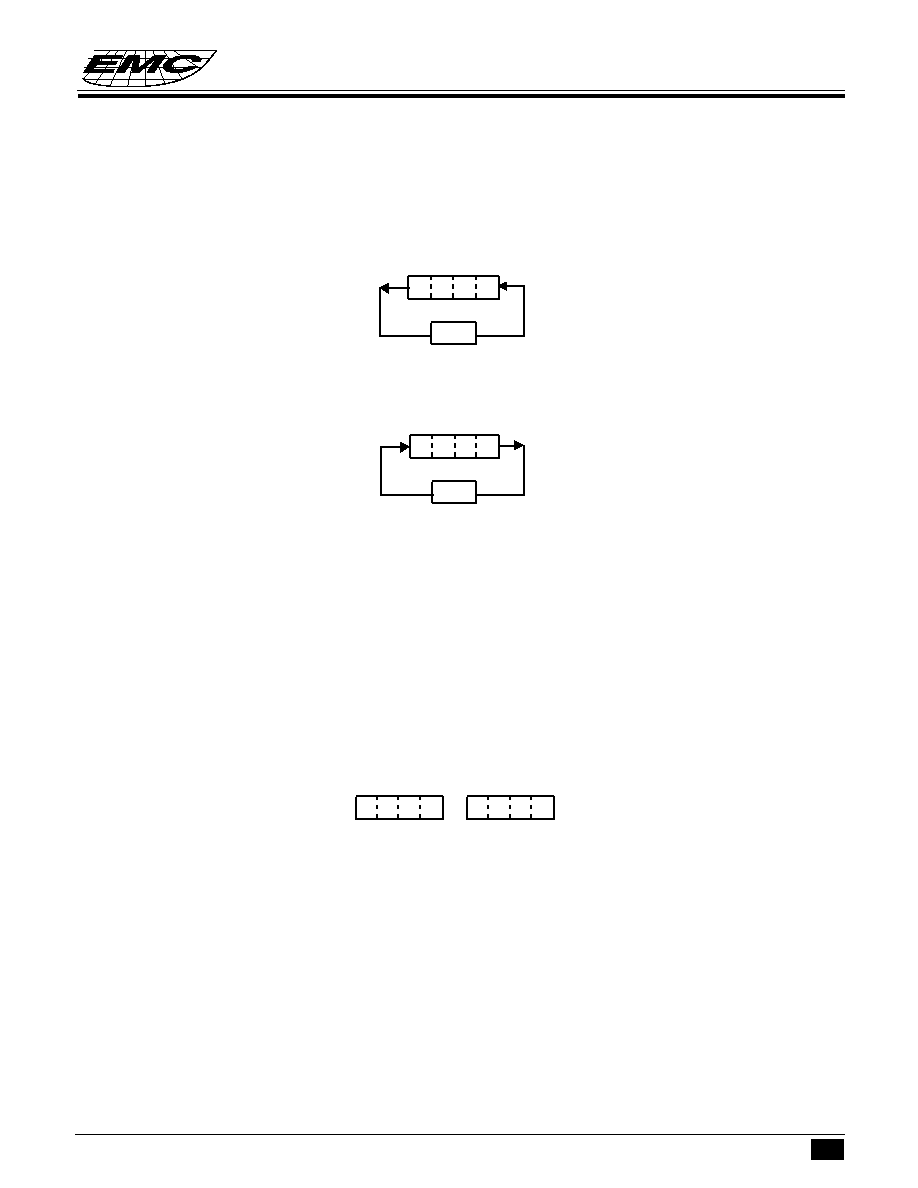
6
* This specification are subject to be changed without notice.
EM73982
EM73982
EM73982
EM73982
EM73982
4-BIT MICROCONTROLLER
4-BIT MICROCONTROLLER
4-BIT MICROCONTROLLER
4-BIT MICROCONTROLLER
4-BIT MICROCONTROLLER
11.30.2001
ACC
CF
MSB
LSB
3 2 1 0
H REGISTER
3 2 1 0
L REGISTER
ACC
CF
MSB
LSB
(3) Rotation:
There are two kinds of rotation operation, one is rotation left, the other is rotation right.
RLCA instruction rotates Acc value to left, shift the CF value into the LSB bit of Acc and the shift out data
will be hold in CF.
RRCA instruction operation rotates Acc value to right, shift the CF value into the MSB bit of Acc and the
shift out data will be hold in CF.
PROGRAM EXAMPLE: To rotate Acc right and shift a "1" into the MSB bit of Acc.
TTCFS; CF
1
RRCA; rotate Acc right and shift CF=1 into MSB.
HL REGISTER
HL REGISTER
HL REGISTER
HL REGISTER
HL REGISTER
HL register are two 4-bit registers, they are used as a pair of pointer for the address of RAM memory and also
2 independent temporary 4-bit data registers. For some instruction, L register can be a pointer to indicate the
pin number (Port4).
HL REGISTER STRUCTURE
HL REGISTER STRUCTURE
HL REGISTER STRUCTURE
HL REGISTER STRUCTURE
HL REGISTER STRUCTURE
HL REGISTER FUNCTION
HL REGISTER FUNCTION
HL REGISTER FUNCTION
HL REGISTER FUNCTION
HL REGISTER FUNCTION
(1) For instruction : LDL #k, LDH #k, THA, THL, INCL, DECL, EXAL, EXAH, HL register used as a
temporary register.
PROGRAM EXAMPLE:
Load immediate data "5h" into L register, "Dh" into H register.
LDL #05h;
LDH #0Dh;

7
* This specification are subject to be changed without notice.
EM73982
EM73982
EM73982
EM73982
EM73982
4-BIT MICROCONTROLLER
4-BIT MICROCONTROLLER
4-BIT MICROCONTROLLER
4-BIT MICROCONTROLLER
4-BIT MICROCONTROLLER
11.30.2001
(2) For instruction LDAM, STAM, STAMI .., HL register used as a pointer for the address of RAM memory.
PROGRAM EXAMPLE: Store immediate data #Ah into RAM of address 35h.
LDL #5h;
LDH #3h;
STDMI #0Ah; RAM[35]
Ah, LR
6
(3) For instruction : SELP, CLPL, TFPL, L regieter be a pointer to indicate the bit of I/O port.
When LR = 0 indicate P4.0
PROGRAM EXAMPLE: To set bit 0 of Port4 to "1"
LDL #00h;
SEPL ; P4.0
1
STACK POINTER (SP)
STACK POINTER (SP)
STACK POINTER (SP)
STACK POINTER (SP)
STACK POINTER (SP)
Stack pointer is a 4-bit register which stores the present stack level number.
Before using stack, user must set the SP value first, CPU will not initiate the SP value after reset condition.
When a new subroutine is accepted, the SP will be decreased one automatically, in another word, if
returning from a subroutine, the SP will be increased one.
The data transfer between ACC and SP is by instruction of "LDASP" and "STASP" at RAM bank0.
DATA POINTER (DP)
DATA POINTER (DP)
DATA POINTER (DP)
DATA POINTER (DP)
DATA POINTER (DP)
Data pointer is a 12-bit register which stores the address of ROM can indicate the ROM code data
specified by user (refer to data ROM).

8
* This specification are subject to be changed without notice.
EM73982
EM73982
EM73982
EM73982
EM73982
4-BIT MICROCONTROLLER
4-BIT MICROCONTROLLER
4-BIT MICROCONTROLLER
4-BIT MICROCONTROLLER
4-BIT MICROCONTROLLER
11.30.2001
.
.
.
SCALL, subroutine call entry address
Data table for
[LDAX],[LDAXI]
instruction
Subroutine call entry address
designated by [LCALL a]
instruction
PROGRAM ROM ( 16K X 8 bits ) for EM73982
PROGRAM ROM ( 16K X 8 bits ) for EM73982
PROGRAM ROM ( 16K X 8 bits ) for EM73982
PROGRAM ROM ( 16K X 8 bits ) for EM73982
PROGRAM ROM ( 16K X 8 bits ) for EM73982
16 K x 8 bits program ROM contains user's program and some fixed data.
The basic structure of program ROM can be divided into 6 parts.
1. Address 0000h: Reset start address.
2. Address 0002h - 000Ch : 5 kinds of interrupt service routine entry addresses.
3. Address 000Eh-0086h : SCALL subroutine entry address, only available at 000Eh,0016h,001Eh,0026h,
002Eh, 0036h, 003Eh, 0046h, 004Eh, 0056h, 005Eh, 0066h, 006Eh, 0076h, 007Eh,
0086h.
4. Address 0000h - 07FFh : LCALL subroutine entry address.
5. Address 0000h - 1FFFh : Except used as above function, the other region can be used as user's program region.
6. Address 1000h - 1FFFh (bank 1, 2, 3) : Only these area could be used as program ROM Data area which used
by LDAX, LDAXI instruction.
address Bank 0 :
0000h
Reset start address
0002h
INT0; interrupt service routine entry address
0004h
Reserved
0006h
TRGA
0008h
TRGB
000Ah
TBI
000Ch
SPI
000Eh
0086h
07FFh
0800h
0FFFh
1000h
Bank 1
1FFFh
Bank 2
Bank 3

9
* This specification are subject to be changed without notice.
EM73982
EM73982
EM73982
EM73982
EM73982
4-BIT MICROCONTROLLER
4-BIT MICROCONTROLLER
4-BIT MICROCONTROLLER
4-BIT MICROCONTROLLER
4-BIT MICROCONTROLLER
11.30.2001
User's program and fixed data are stored in the program ROM. User's program is according the PC value
to send next executed instruction code.
The 16Kx8 bits program ROM can be divided into 4 banks. There are 4Kx8 bits each bank.
The bank of the program ROM is selected by P3(1..0). The program counter is a 13-bit binary counter. The PC
and P3 are initialized to "0" during reset.
When P3(1..0)=00B, the bank0 and bank1 of program ROM will be selected. P3(1..0)=01B, the the bank0 and
bank2 will be selected. P3(1..0)=01B, the bank0 and bank3 will be selected.
Address
P3=xx00B
P3=xx01B
P3=xx10b
0000h
:
:
Bank0
Bank0
Bank0
0FFFh
1000h
:
:
Bank1
Bank2
Bank3
1FFFh
PROGRAM EXAMPLE:
BANK 0
START:
:
:
:
LDIA
#00H
; set program ROM to bank1
OUTA P3
B
XA1
:
XA :
:
:
LDIA
#01H
; set program ROM to bank2
OUTA P3
B
XB1
:
XB :
:
:
LDIA
#02H
; set program ROM to bank3
OUTA P3
B
XC1
:
XC :
:
:
B
XD
XD :
:
:
:
; - - - - - - - - - - - - - - - - - - - - - - - - - - - - - - - - - - - - - - - - - - - - - - - - - - - - - - - - - - - - - - - - - - - - - - - - - - -
- -
BANK
1
XA1 :
:
:
B
XA
:
XA2 :
:

10
* This specification are subject to be changed without notice.
EM73982
EM73982
EM73982
EM73982
EM73982
4-BIT MICROCONTROLLER
4-BIT MICROCONTROLLER
4-BIT MICROCONTROLLER
4-BIT MICROCONTROLLER
4-BIT MICROCONTROLLER
11.30.2001
B
XA2
:
; - - - - - - - - - - - - - - - - - - - - - - - - - - - - - - - - - - - - - - - - - - - - - - - - - - - - - - - - - - - - - - - - - - - - - - - - - - - - -
BANK 2
XB1 :
:
:
B
XB
:
XB2 :
:
B
XB2
:
; - - - - - - - - - - - - - - - - - - - - - - - - - - - - - - - - - - - - - - - - - - - - - - - - - - - - - - - - - - - - - - - - - - - - - - - - - - - - -
BANK 3
XC1 :
:
:
B
XC
:
XC2 :
:
B
XC2
Fixed data can be read out by table-look-up instruction. Table-look-up instruction is depended on the Data
Pointer (DP) to indicate the ROM address, then to get the ROM code data :
LDAX
LDAX
LDAX
LDAX
LDAX
Acc
Acc
Acc
Acc
Acc
ROM[DP]
ROM[DP]
ROM[DP]
ROM[DP]
ROM[DP]
L
L
L
L
L
LDAXI
LDAXI
LDAXI
LDAXI
LDAXI
Acc
Acc
Acc
Acc
Acc
ROM[DP]
ROM[DP]
ROM[DP]
ROM[DP]
ROM[DP]
H
H
H
H
H
,DP+1
,DP+1
,DP+1
,DP+1
,DP+1
DP is a 12-bit data register which can store the program ROM address to be the pointer for the ROM code data.
First, user load ROM address into DP by instruction "STADPL, STADPM, STADPH", then user can get the
lower nibble of ROM code data by instruction "LDAX" and higher nibble by instruction "LDAXI".
To access DP (LDADPL, LDADPM, LDADPH, STADPL, STADPM, STADPH), user must switch RAM
at BANK0.
PROGRAM EXAMPLE: Read out the ROM code of address 1777h by table-look-up instruction.
LDIA #07h;
STADPL
; [DP]
L
07h
STADPM
; [DP]
M
07h
STADPH
; [DP]
H
07h, Load DP=777h
:
LDL #00h
;
LDH #03h
;
OUT #00H,P3
;
LDAX
; ACC
6h
STAMI
; RAM[30]
6h
LDAXI
; ACC
5h
STAM
; RAM[31]
5h
;
ORG 1777h
DATA 56h
;
DATA RAM ( 372-nibble )
DATA RAM ( 372-nibble )
DATA RAM ( 372-nibble )
DATA RAM ( 372-nibble )
DATA RAM ( 372-nibble )
There is total 372 - nibble data RAM from address 000 to 17Fh
Data RAM includes 3 parts: zero page region, stacks and data area.

11
* This specification are subject to be changed without notice.
EM73982
EM73982
EM73982
EM73982
EM73982
4-BIT MICROCONTROLLER
4-BIT MICROCONTROLLER
4-BIT MICROCONTROLLER
4-BIT MICROCONTROLLER
4-BIT MICROCONTROLLER
11.30.2001
ZERO- PAGE:
From 000h to 00Fh is the location of zero-page. It is used as the pointer in zero -page addressing mode for the
instruction of "STD #k,y; ADD #k,y; CLR y,b; CMP k,y".
PROGRAM EXAMPLE: To wirte immediate data "07h" to address "003h" of RAM and to clear bit 2 of RAM.
STD #07h, 03h ; RAM[03]
07h
CLR 0Eh,2 ; RAM[0Eh]
2
0
STACK:
There are 13 - level (maximum) stack for user using for subroutine (including interrupt and CALL). User
can assign any level to be the starting stack by giving the level number to stack pointer (SP).
When user using any instruction of CALL or subroutine, before entry the subroutine, the previous PC address
will be saved into stack until return from those subroutines, the PC value will be restored by the data saved
in stack.
DATA AREA:
Except the special area used by user, the whole RAM can be used as data area for storing and loading general
data.
ADDRESSING MODE
The 372 nibble data memory consists two banks (bank 0 and bank 1). There are 244x4 bits (address
000h~0F3h) on bank 0 and 128x4 bits (address 100h~17Fh) on bank 1.
Increment
Address
020h - 02Fh
0C0h - 0CFh
0D0h - 0DFh
0E0h - 0EFh
Level 0
Level 4
Level 8
Level 12
Level 1
Level 5
Level 9
Level 2
Level 6
Level 10
Level 3
Level 7
Level 11
Increment
Zero-page
000h - 00Fh
010h - 01Fh
0F0h - 0F3h
:
:
:
110h - 11Fh
160h - 16Fh
170h - 17Fh
100h - 10Fh
:
:
:
Bank 0
Bank 1
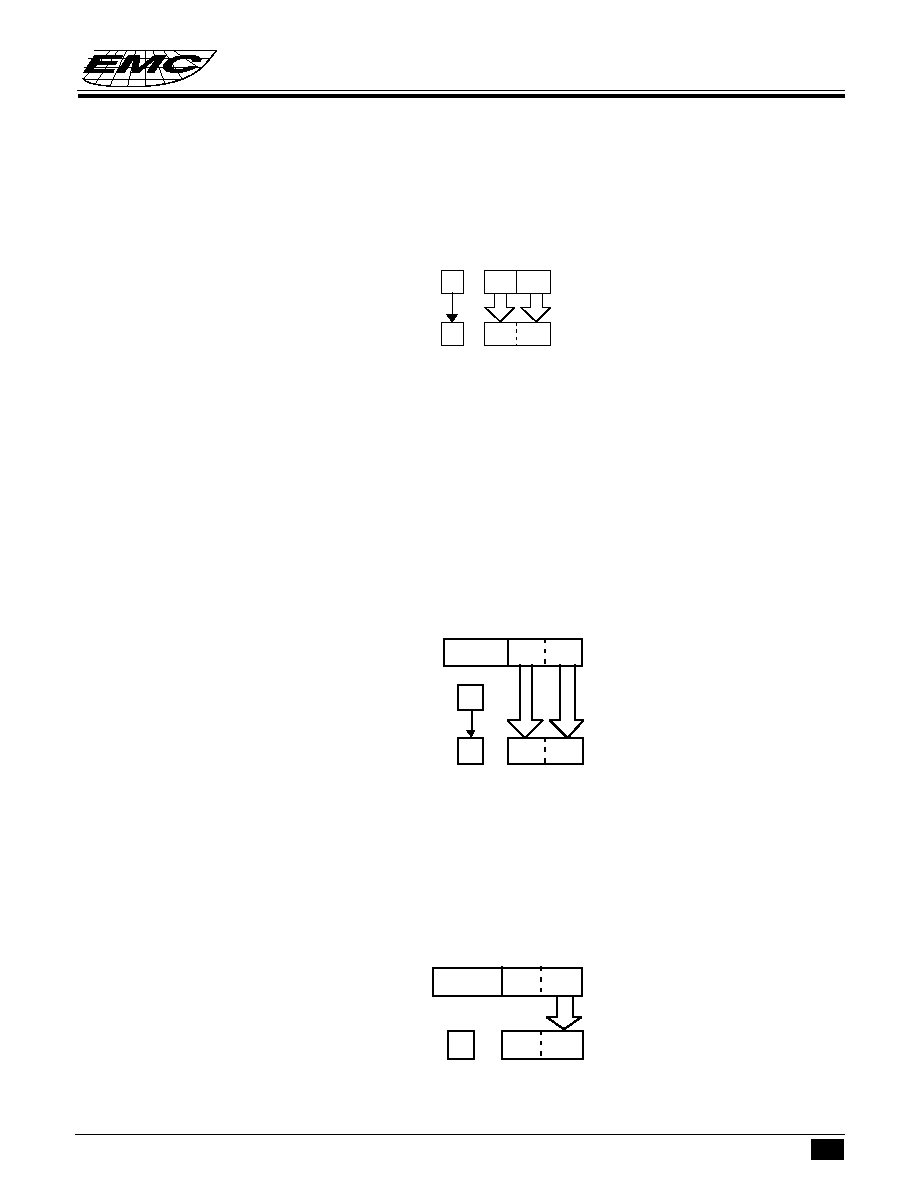
12
* This specification are subject to be changed without notice.
EM73982
EM73982
EM73982
EM73982
EM73982
4-BIT MICROCONTROLLER
4-BIT MICROCONTROLLER
4-BIT MICROCONTROLLER
4-BIT MICROCONTROLLER
4-BIT MICROCONTROLLER
11.30.2001
P9.3
instruction field
RAM address
xxxx xxxx
xxxx xxxx
0
instruction field
RAM address
yyyy
0000 yyyy
There are three addressing modes in the data memory :
(1) Indirect addressing mode:
The bank is selected by P9.3. When P9.3 is cleared to "0", the bank 0 is selected.
When P9.3 is set to "1", the bank 1 is selected. The address in the bank are specified by the HL registers.
PROGRAM EXAMPLE: Load the data of RAM address "143h" to RAM address "023h".
SEP P9,3 ; P9.3
1
LDL #3h
; LR
3
LDH #4h
; HR
4
LDAM
; Acc
RAM[134h]
CLP P9,3 ; P9.3
0
LDL #2h
; LR
2
LDH #3h
; HR
3
STAM
; RAM[023h]
Acc
(2) Direct addressing mode:
The bank is selected by P9.3. When P9.3 is cleared to "0", the bank 0 is selected.
When P9.3 is set to "1", the bank 1 is selected. The address in the bank are directly specified by 8 bits of the
second byte in the instruction field.
PROGRAM EXAMPLE: Load the data of RAM address "143h" to RAM address "023h".
SEP P9,3 ; P9.3
1
LDA 43h
; Acc
RAM[134h]
CLP P9,3 ; P9.3
0
STA 23h
; RAM[023h]
Acc
(3) Zero-page addressing mode:
The zero-page is the bank 0 (address 000h~00Fh). The address are the lower 4 bits of the second byte in the
instruction field.
PROGRAM EXAMPLE: Write immediate "0Fh" to RAM address "005h".
STD #0Fh, 05h ; RAM[05h]
0Fh
P9.3
HR
LR
RAM address

13
* This specification are subject to be changed without notice.
EM73982
EM73982
EM73982
EM73982
EM73982
4-BIT MICROCONTROLLER
4-BIT MICROCONTROLLER
4-BIT MICROCONTROLLER
4-BIT MICROCONTROLLER
4-BIT MICROCONTROLLER
11.30.2001
+2
PROGRAM COUNTER
PROGRAM COUNTER
PROGRAM COUNTER
PROGRAM COUNTER
PROGRAM COUNTER
Program counter ( PC ) is composed by a 13-bit counter, which indicates the next executed address for the
instruction of program ROM.
For a 8K - byte size ROM, PC can indicate address form 0000h - 1FFFh, for BRANCH and CALL instrcutions,
PC is changed by instruction indicating.
(1) Branch instruction:
(1) Branch instruction:
(1) Branch instruction:
(1) Branch instruction:
(1) Branch instruction:
SBR a
SBR a
SBR a
SBR a
SBR a
Object code: 00aa aaaa
Condition: SF=1; PC
PC
12-6.a
(branch condition satisified)
PC Hold original PC value+1
a
a
a
a
a
a
SF=0; PC
PC +1 (branch condition not satisified)
PC Original PC value + 1
LBR a
LBR a
LBR a
LBR a
LBR a
Object code: 1100 aaaa aaaa aaaa
Condition: SF=1; PC
PC
12.a
(branch condition satisified)
PC
Hold
a
a
a
a
a
a a
a
a
a
a
a
SF=0; PC
PC +2 (branch condition not satisified)
PC Original PC value + 2
SLBR a
SLBR a
SLBR a
SLBR a
SLBR a
Object code: 0101 0101 1100 aaaa aaaa aaaa (a:1000h~1FFFh)
0101 0111 1100 aaaa aaaa aaaa (a:0000h~0FFFh)
Condition: SF=1; PC
a (branch condition satisified)
PC a
a
a
a
a
a
a
a
a
a
a
a
a
SF=0 ; PC
PC + 3 (branch condition not satisified)
PC
Original PC value + 3
(2) Subroutine instruction:
(2) Subroutine instruction:
(2) Subroutine instruction:
(2) Subroutine instruction:
(2) Subroutine instruction:
SCALL a
SCALL a
SCALL a
SCALL a
SCALL a
Object code: 1110 nnnn
Condition : PC
a ; a=8n+6 ; n=1..Fh ; a=86h, n=0
PC 0
0
0
0
0
a
a
a
a
a
1
1
0
LCALL a
LCALL a
LCALL a
LCALL a
LCALL a
Object code: 0100 0aaa aaaa aaaa
Condition: PC
a
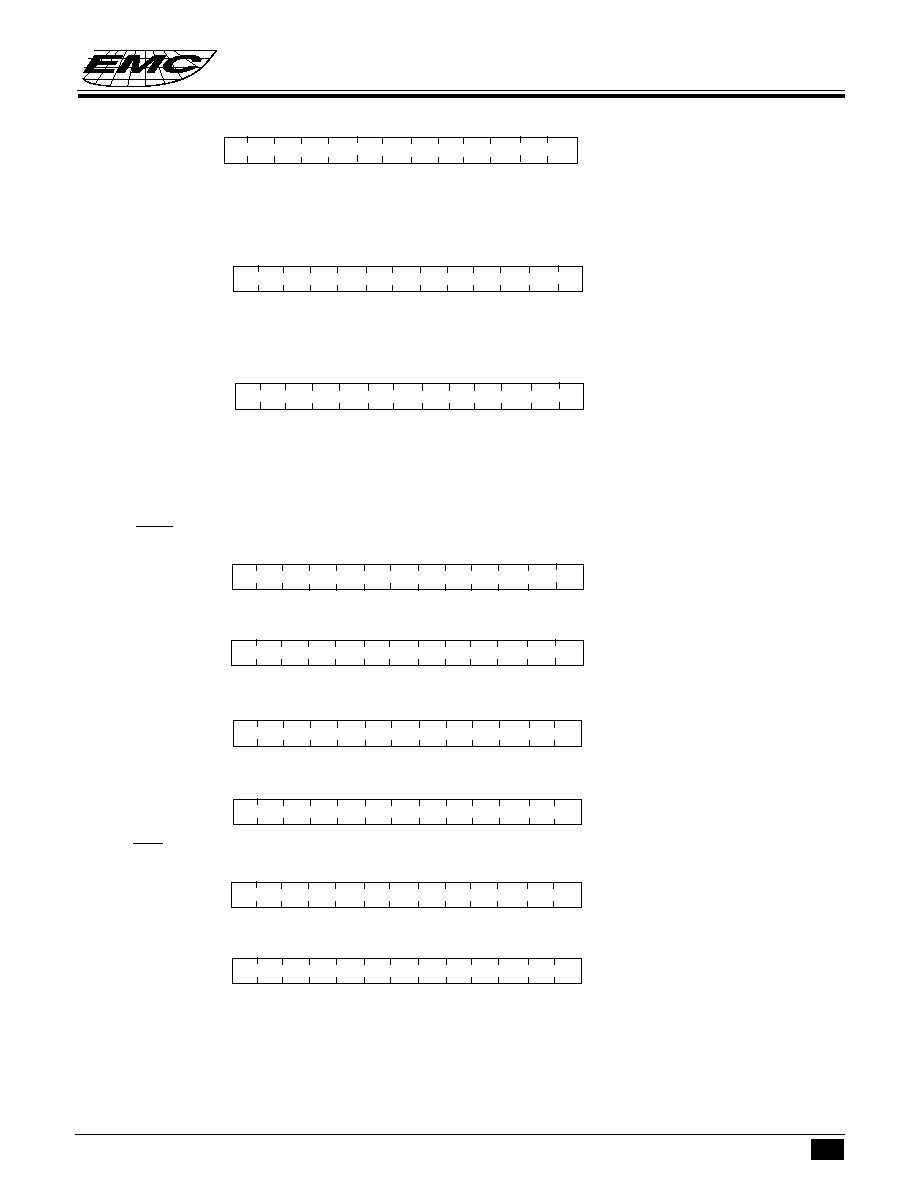
14
* This specification are subject to be changed without notice.
EM73982
EM73982
EM73982
EM73982
EM73982
4-BIT MICROCONTROLLER
4-BIT MICROCONTROLLER
4-BIT MICROCONTROLLER
4-BIT MICROCONTROLLER
4-BIT MICROCONTROLLER
11.30.2001
PC 0
0
a
a
a
a
a
a
a
a
a
a
a
RET
RET
RET
RET
RET
Object code: 0100 1111
Condition: PC
STACK[SP]; SP + 1
PC
The return address stored in stack
RT I
RT I
RT I
RT I
RT I
Object code: 0100 1101
Condition : FLAG. PC
STACK[SP]; EI
1; SP + 1
PC
The return address stored in stack
(3) Interrupt acceptance operation:
(3) Interrupt acceptance operation:
(3) Interrupt acceptance operation:
(3) Interrupt acceptance operation:
(3) Interrupt acceptance operation:
When an interrupt is accepted, the original PC is pushed into stack and interrupt vector will be loaded into
PC,The interrupt vectors are as following:
INT0
INT0
INT0
INT0
INT0 (External interrupt from P8.2)
PC 0
0
0
0
0
0
0
0
0
0
0
1
0
TRGA
TRGA
TRGA
TRGA
TRGA (Timer A overflow interrupt)
PC 0
0
0
0
0
0
0
0
0
0
1
1
0
TRGB
TRGB
TRGB
TRGB
TRGB (Time B overflow interrupt)
PC 0
0
0
0
0
0
0
0
0
1
0
0
0
TBI
TBI
TBI
TBI
TBI (Time base interrupt)
PC 0
0
0
0
0
0
0
0
0
1
0
1
0
SPI
SPI
SPI
SPI
SPI (Speech ending interrupt)
PC 0
0
0
0
0
0
0
0
0
1
1
0
0
(4) Reset operation:
(4) Reset operation:
(4) Reset operation:
(4) Reset operation:
(4) Reset operation:
PC 0
0
0
0
0
0
0
0
0
0
0
0
0
(5) Other operations:
(5) Other operations:
(5) Other operations:
(5) Other operations:
(5) Other operations:
For 1-byte instruction execution: PC + 1
For 2-byte instruction execution: PC + 2
For 3-byte instruction execution: PC + 3
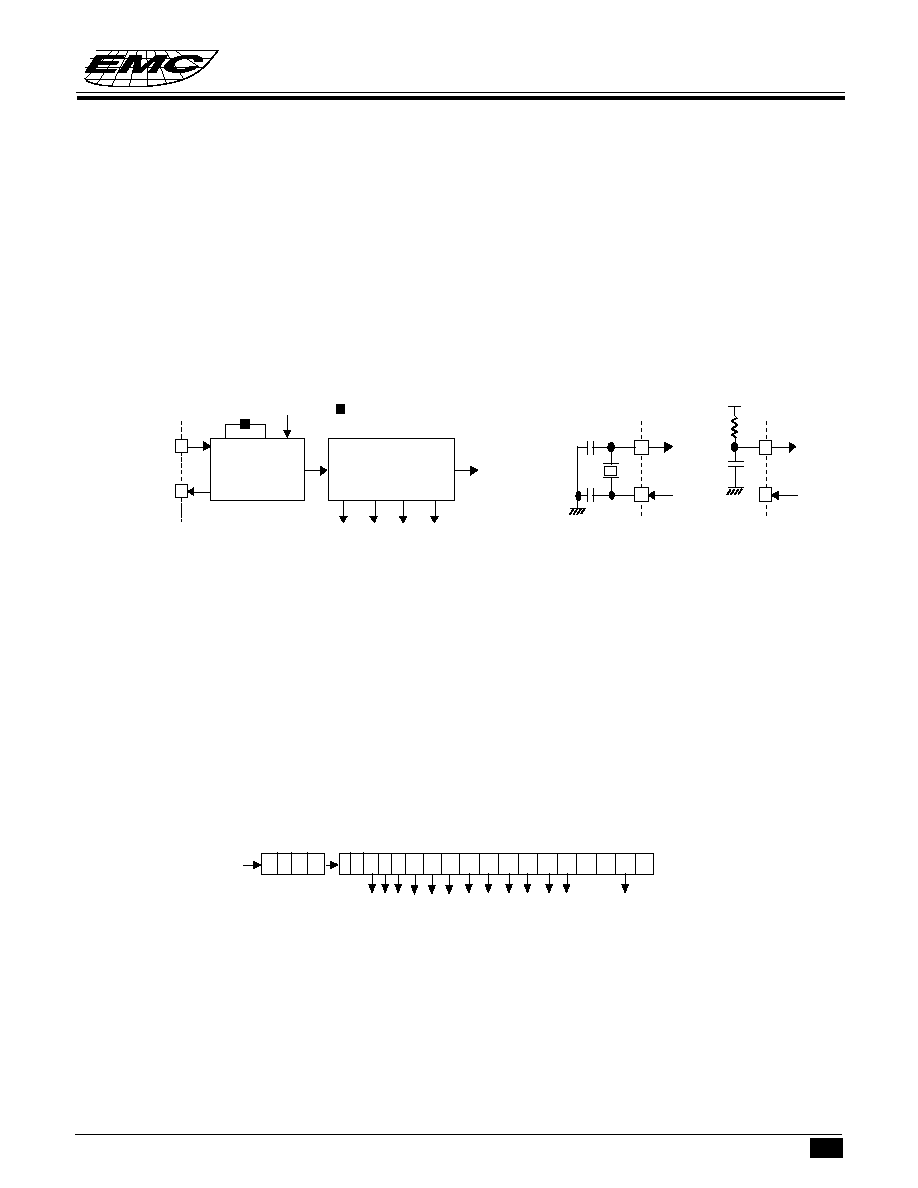
15
* This specification are subject to be changed without notice.
EM73982
EM73982
EM73982
EM73982
EM73982
4-BIT MICROCONTROLLER
4-BIT MICROCONTROLLER
4-BIT MICROCONTROLLER
4-BIT MICROCONTROLLER
4-BIT MICROCONTROLLER
11.30.2001
CLOCK AND TIMING GENERATOR
CLOCK AND TIMING GENERATOR
CLOCK AND TIMING GENERATOR
CLOCK AND TIMING GENERATOR
CLOCK AND TIMING GENERATOR
The clock generator is supported by a single clock system, the clock source comes from crystal (resonator)
or RC oscillation is decided by mask option, the working frequency range is 480 K Hz to 4 MHz.
CLOCK AND TIMING GENERATOR STRUCTURE
CLOCK AND TIMING GENERATOR STRUCTURE
CLOCK AND TIMING GENERATOR STRUCTURE
CLOCK AND TIMING GENERATOR STRUCTURE
CLOCK AND TIMING GENERATOR STRUCTURE
The clock generator connects outside compoments (crystal or resonator by XIN and XOUT pin for crystal
osc. type, Resistor and capacitor by CLK pin for RC osc type, these two type is decided by mask option).
The clock generator generates a basic system clock "fc".
When CPU sleeping, the clock generator will be stoped until the sleep condition released.
The system clock control generates 4 basic phase signals (S1, S2, S3, S4) and system clock.
CLOCK AND TIMING GENERATOR FUNCTION
CLOCK AND TIMING GENERATOR FUNCTION
CLOCK AND TIMING GENERATOR FUNCTION
CLOCK AND TIMING GENERATOR FUNCTION
CLOCK AND TIMING GENERATOR FUNCTION
The frequency of fc is the oscillation frequency for XIN, XOUT by crystal ( resonator) or for CLK by RC osc.
When CPU sleeps, the XOUT pin will be in "high" state. When user choose RC osc, XOUT pin is no used.
The instruction cycle equal 8 basic clock fc.
1 instructure cycle = 8 / fc
TIMING GENERATOR AND TIME BASE
TIMING GENERATOR AND TIME BASE
TIMING GENERATOR AND TIME BASE
TIMING GENERATOR AND TIME BASE
TIMING GENERATOR AND TIME BASE
The timing generator produces the system clock from basic clock pulse.
1 instruction cycle = 8 basic clock pulses
There are 22 stages time base.
When working in the single clock mode, the timebase clock source is come from fc.
Time base provides basic frequency for following function:
1. TBI (time base interrupt).
2. Timer/counter, internal clock source.
3. Warm-up time for sleep - mode releasing.
XIN/CLK
XOUT
Crystal connection
XIN/CLK
XOUT
RC connection
sleep
XIN/CLK
XOUT
clock generator
System clock control
fc
System clock
S1
S2
S3
S4
Mask option
Mask option for choose Crystal or RC oscillation
fc
Prescaler
Binary counter
1 2 3
4
5 6 7 8 9 10 11 12 13
22
21
20
19
18
17
16
15
14

16
* This specification are subject to be changed without notice.
EM73982
EM73982
EM73982
EM73982
EM73982
4-BIT MICROCONTROLLER
4-BIT MICROCONTROLLER
4-BIT MICROCONTROLLER
4-BIT MICROCONTROLLER
4-BIT MICROCONTROLLER
11.30.2001
TIME BASE INTERRUPT (TBI )
TIME BASE INTERRUPT (TBI )
TIME BASE INTERRUPT (TBI )
TIME BASE INTERRUPT (TBI )
TIME BASE INTERRUPT (TBI )
The time base can be used to generate a fixed frequency interrupt. There are 8 kinds of frequencies can be
selected by setting "P25"
Single clock mode
P25 3
2
1
0
( initial value 0000 )
0 0 x x: Interrupt disable
0 1 0 0: Interrupt frequency XIN / 2
10
Hz
0 1 0 1: Interrupt frequency XIN / 2
11
Hz
0 1 1 0: Interrupt frequency XIN / 2
12
Hz
0 1 1 1: Interrupt frequency XIN / 2
13
Hz
1 1 0 0: Interrupt frequency XIN / 2
9
Hz
1 1 0 1: Interrupt frequency XIN / 2
8
Hz
1 1 1 0: Interrupt frequency XIN / 2
15
Hz
1 1 1 1: Interrupt frequency XIN / 2
17
Hz
1 0 x x: Reserved
TIMER / COUNTER ( TIMERA, TIMERB)
TIMER / COUNTER ( TIMERA, TIMERB)
TIMER / COUNTER ( TIMERA, TIMERB)
TIMER / COUNTER ( TIMERA, TIMERB)
TIMER / COUNTER ( TIMERA, TIMERB)
Timer/counters can support user three special functions:
1. Even counter
2. Timer.
3. Pulse-width measurement.
These three functions can be executed by 2 timer/counter independently.
For timerA, the counter data is saved in timer register TAH, TAM, TAL, which user can set counter initial
value and read the counter value by instruction "LDATAH(M,L), STATAH(M,L)" and timer register is
TBH, TBM, TBL and W/R instruction "LDATBH (M,L), STATBH (M,L)".
The basic structure of timer/counter is composed by two same structure counter, these two counters can be
set initial value and send counter value to timer register, P28 and P29 are the command ports for timerA
and timer B, user can choose different operation mode and different internal clock rate by setting these two
ports. When timer/counter overflow, it will generate a TRGA(B) interrupt request to interrupt control unit.
To access TA, TB, user must switch RAM at bank0.

17
* This specification are subject to be changed without notice.
EM73982
EM73982
EM73982
EM73982
EM73982
4-BIT MICROCONTROLLER
4-BIT MICROCONTROLLER
4-BIT MICROCONTROLLER
4-BIT MICROCONTROLLER
4-BIT MICROCONTROLLER
11.30.2001
Port 28
3 2 1 0
TMSA
IPSA
Initial state: 0000
TIMER/COUNTER MODE SELECTION
TMSA (B) Function description
0 0
Stop
0 1
Event counter mode
1 0
Timer mode
1 1
Pulse width measurement mode
Port 29
3 2 1 0
TMSB
IPSB
Initial state: 0000
INTERRUPT CONTROL
TRGA request
P8.3/
TRGA
EVENT COUNTER CONTROL
TIMER CONTROL
internal clock
P28
12 BIT COUNTER
TMSA
IPSA
DATA BUS
P8.1/
TRGB
EVENT COUNTER CONTROL
TIMER CONTROL
internal clock
P29
12 BIT COUNTER
TMSB
IPSB
TRGB request
PULSE-WIDTH MEASUREMENT
CONTROL
PULSE-WIDTH MEASUREMENT
CONTROL
TIMER/COUNTER CONTROL
TIMER/COUNTER CONTROL
TIMER/COUNTER CONTROL
TIMER/COUNTER CONTROL
TIMER/COUNTER CONTROL
P8.1/TRGB, P8.3/TRGA are the external timer inputs for timerB and timerA, they are used in event
counter and pulse-width measurement mode.
Timer/counter command port: P28 is the command port for timer/counterA and P29 is for the timer/
counterB.
INTERNAL PULSE-RATE SELECTION
IPSA(B) Function description
0 0
XIN/2 Hz
0 1
XIN/2 Hz
1 0
XIN/2 Hz
1 1
XIN/2 Hz
10
14
18
22

18
* This specification are subject to be changed without notice.
EM73982
EM73982
EM73982
EM73982
EM73982
4-BIT MICROCONTROLLER
4-BIT MICROCONTROLLER
4-BIT MICROCONTROLLER
4-BIT MICROCONTROLLER
4-BIT MICROCONTROLLER
11.30.2001
Internal pulse
TimerB (TimerA )value
n
n+1
n+2
n+3
n+4
n+5
n+6
n+7
P8.1/TRGB (P8.3/TRGA)
TimerB (TimerA) value n
n+1
n+2
n+3
n+4
n+5
n+6
TIMER/COUNTER FUNCTION
TIMER/COUNTER FUNCTION
TIMER/COUNTER FUNCTION
TIMER/COUNTER FUNCTION
TIMER/COUNTER FUNCTION
Timer/counterA can be programmable for timer, event counter and pulse width measurement. Each timer/
counter can execute any one of these functions independly.
EVENT COUNTER MODE
For event counter mode, timer/counter increases one at any rising edge of P8.1/TRGB for timerB (P8.3/
TRGA for timer A). When timerB (timerA) counts overflow, it will give interrupt control an interrupt request
TRGB (TRGA).
PROGRAM EXAMPLE: Enable timerA with P28
LDIA #0100B;
OUTA P28; Enable timerA with event counter mode
TIMER MODE
For timer mode, timer/counter increase one at any rising edge of internal pulse. User can choose 4 kinds
of internal pulse rate by setting IPSB for timerB (IPSA for timerA).
When timer/counter counts overflow, TRGB (TRGA) will be generated to interrupt control unit.
PROGRAM EXAMPLE: To generate TRGA interrupt request after 60 ms with system clock XlN=4MHz
LDIA #0100B;
EXAE; enable mask 2
EICIL 110111B; interrupt latch
0, enable EI
LDIA #06H;
STATAL;
LDIA #01H;
STATAM;
LDIA #0FH;
STATAH;
LDIA #1000B;
OUTA P28; enable timerA with internal pulse rate: XIN/2
10
Hz
NOTE:
The preset value of timer/counter register is calculated as following procedure.
Internal pulse rate: XIN/2
10
; XIN = 4MHz
The time of timer counter count one = 2
10
/XIN = 1024/4000=0.256ms
The number of internal pulse to get timer overflow = 60 ms/ 0.256ms = 234.375 = 0EAH
The preset value of timer/counter register = 1000H - 0EAH = 0F16H
PULSE WIDTH MEASUREMENT MODE

19
* This specification are subject to be changed without notice.
EM73982
EM73982
EM73982
EM73982
EM73982
4-BIT MICROCONTROLLER
4-BIT MICROCONTROLLER
4-BIT MICROCONTROLLER
4-BIT MICROCONTROLLER
4-BIT MICROCONTROLLER
11.30.2001
For the pulse width measurement mode, the counter only incresed by the rising edge of internal pulse rate as
external timer/counter input (P8.1/TRGB, P8.3/TRGA), interrupt request will be generated as soon as
timer/counter count overflow.
Internal pulse
TimerB(TimerA) value
n
n+1
n+2
n+3
n+4
n+5
P8.1/TRGB(P8.3/TRGA)
PROGRAM EXAMPLE:
Enable timerA by pulse width measurement mode.
LDIA #1100b;
OUTA P28; Enable timerA with pulse width measurement mode.
INTERRUPT FUNCTION
INTERRUPT FUNCTION
INTERRUPT FUNCTION
INTERRUPT FUNCTION
INTERRUPT FUNCTION
There are 5 interrupt sources, 2 external interrupt sources, 3 internal interrupt sources. Multiple
interrupts are admitted according the priority.
Type
Type
Type
Type
Type
Interrupt source
Interrupt source
Interrupt source
Interrupt source
Interrupt source
Priority
Priority
Priority
Priority
Priority
Interrupt
Interrupt
Interrupt
Interrupt
Interrupt
Interrupt
Interrupt
Interrupt
Interrupt
Interrupt
Program ROM
Program ROM
Program ROM
Program ROM
Program ROM
Latch
Latch
Latch
Latch
Latch
Enable condition
Enable condition
Enable condition
Enable condition
Enable condition
entry address
entry address
entry address
entry address
entry address
External
External interrupt(INT0)
1
IL5
EI=1
002h
Internal
Reserved
2
IL4
EI=1, MASK3=1
004h
Internal
TimerA overflow interrupt (TRGA)
3
IL3
EI=1, MASK2=1
006h
Internal
TimerB overflow interrupt (TRGB)
4
IL2
EI=1, MASK1=1
008h
Internal
Time base interrupt(TBI)
5
IL1
00Ah
Internal
Speech ending interrupt (SPI)
6
IL0
EI=1,MASK0=1
00Ch
INTERRUPT STRUCTURE
INTERRUPT STRUCTURE
INTERRUPT STRUCTURE
INTERRUPT STRUCTURE
INTERRUPT STRUCTURE
Interrupt controller:
IL0-IL5
: Interrupt latch. Hold all interrupt requests from all interrupt sources. ILr can not be
set by program, but can be reset by program or system reset, so IL only can decide
which interrupt source can be accepted.
MASK0-MASK3
: Except INT0, MASK register can promit or inhibit all interrupt sources.
MASK0 MASK1 MASK1 MASK2 MASK3
IL0
r0
IL1
TBI
r1
Reset by system reset and program
instruction
IL2
r2
IL3
TRGA
r3
IL4
r4
IL5
INT0
r5
Priority checker
EI
Entry address generator
Interrupt request
Interrupt entry address
Reset by system reset and program
instruction
Set by program instruction
by EICIL or DICIL
TRGB
SPI
Reserved

20
* This specification are subject to be changed without notice.
EM73982
EM73982
EM73982
EM73982
EM73982
4-BIT MICROCONTROLLER
4-BIT MICROCONTROLLER
4-BIT MICROCONTROLLER
4-BIT MICROCONTROLLER
4-BIT MICROCONTROLLER
11.30.2001
EI
: Enable interrupt Flip-Flop can promit or inhibit all interrupt sources, when inter-
rupt happened, EI is cleared to "0" automatically, after RTI instruction happened,
EI will be set to "1" again.
Priority checker: Check interrupt priority when multiple interrupts happened.
INTERRUPT FUNCTION
INTERRUPT FUNCTION
INTERRUPT FUNCTION
INTERRUPT FUNCTION
INTERRUPT FUNCTION
The procedure of interrupt operation:
1. Push PC and all flags to stack.
2. Set interrupt entry address into PC.
3. Set SF= 1.
4. Clear EI to inhibit other interrupts happened.
5. Clear the IL for which interrupt source has already be accepted.
6. To excute interrupt subroutine from the interrupt entry address.
7. CPU accept RTI, restore PC and flags from stack. Set EI to accept other interrupt requests.
PROGRAM EXAMPLE: To enable interrupt of "INT0, TRGA"
LDIA #1100B;
EXAE; set mask register "1100B"
EICIL 111111B ; enable interrupt F.F.
POWER SAVING FUNCTION ( Sleep / Hold functlon )
POWER SAVING FUNCTION ( Sleep / Hold functlon )
POWER SAVING FUNCTION ( Sleep / Hold functlon )
POWER SAVING FUNCTION ( Sleep / Hold functlon )
POWER SAVING FUNCTION ( Sleep / Hold functlon )
During sleep and hold condition, CPU holds the system's internal status with a low power consumption, for
the sleep mode, the system clock will be stoped in the sleep condition and system need a warm up time for
the stability of system clock running after wakeup. In the other way, for the hold mode, the system clock
does not stop at all and it does not need a warm-up time any way.
The sleep and hold mode is controlled by Port 16 and released by P0(0..3)/WAKEUP0..3 or P8(0..3)/
WAKEUPA..D.
Sleep and hold condition:
1. Osc stop (sleep only) and CPU internal status held.
2. Internal time base clear to "0".
P16 3 2 1 0
initial value :0000
SWWT Set wake-up warm-up time
2 /XIN
2 /XIN
2 /XIN
Hold mode
SE Enable sleep/hold
0 Reserved
1 Enable sleep / hold rnode
0
1
Wake-up in edge release mode
Wake-up in level release mode
0 0
0 1
1 0
1 1
18
14
16
WM SE SWWT
WM Set wake-up release mode
3. CPU internal memory, flags, register, I/O held original states.
4. Program counter hold the executed address after sleep release.
Release condition:
1. Osc start to oscillating (sleep only).
2. Warm-up time passing (sleep only).
3. According PC to execute the following program.

21
* This specification are subject to be changed without notice.
EM73982
EM73982
EM73982
EM73982
EM73982
4-BIT MICROCONTROLLER
4-BIT MICROCONTROLLER
4-BIT MICROCONTROLLER
4-BIT MICROCONTROLLER
4-BIT MICROCONTROLLER
11.30.2001
There is only one kind of sleep/hold release mode.
1. Edge release mode:
Release sleep/hold condition by the falling edge of any one of P0(0..3)/WAKEUP0..3 or P8(0..3)/
WAKEUPA..D.
Note : There are 8 independent mask options for wakeup function in EM73962. So, the wakeup function
of P0(0..3)/WAKEUP0..3 and P8(0..3)/WAKEUPA..D are enabled or disabled independently.
LCD DRIVER
LCD DRIVER
LCD DRIVER
LCD DRIVER
LCD DRIVER
It can directly drive the liquid crystal display ( LCD ) and has 40 segments, 8 commons output pins.
There are total 40x8 dots can be display. The VRLC pin is the LCD driver power input, there is the voltage
of ( Vcc - VRLC ) to LCD.
(1) LCD driver control command register:
Port27 3
2
1
0
Initial value: 0h
LDC
LDC
LDC
LDC
LDC *
*
*
*
*
*
*
*
*
*
LCD DISPLAY CONTROL
LCD DISPLAY CONTROL
LCD DISPLAY CONTROL
LCD DISPLAY CONTROL
LCD DISPLAY CONTROL
LDC
Function description
0
0
LCD display disable
0
1
Blanking, change COMMON pin output
1
0
Reserved
1
1
LCD display enable
* : Don't care.
P27 is the LDC driver control command register. The initial value is 0000.
When LDC ( bit2 and bit3 of P27 ) is set to "0000", the LCD display is disabled.
When LDC is set to "0010", the LCD is blanking, the COM pins are inactive and the SEG pins continuously
output the display data.
The power switch of LCD driver is turned off when the CPU is reseted.
When LDC is set to "0110", the LCD display is enabled, the power switch is turned on and it can not be turned
off forever except the CPU is reseted again.
The power switch is also turned off during the sleep operation. Users must enable the LCD display again
by self when the CPU is waked up.
(2) LCD display data area:
(2) LCD display data area:
(2) LCD display data area:
(2) LCD display data area:
(2) LCD display data area:
The LCD display data is stored in the display data area of the data memory (RAM).
The display data area begins with address 20H during reset. The LCD display data area is as below:
C O M 0
C O M 1
C O M 2
C O M 3
C O M 4
C O M 5
C O M 6
C O M 7
20H
30H
40H
50H
60H
70H
80H
90H
b
i
t
0
b
i
t
1
b
i
t
2
b
i
t
3
S
E
G
0
S
E
G
1
S
E
G
2
S
E
G
3
S
E
G
4
S
E
G
5
S
E
G
6
S
E
G
7
S
E
G
8
S
E
G
9
S
E
G
1
0
S
E
G
1
1
S
E
G
1
2
S
E
G
1
3
S
E
G
1
4
S
E
G
1
5
S
E
G
1
6
S
E
G
1
7
S
E
G
1
8
S
E
G
1
9
S
E
G
2
0
S
E
G
2
1
S
E
G
2
2
S
E
G
2
3
S
E
G
2
4
S
E
G
2
5
S
E
G
2
6
S
E
G
2
7
S
E
G
2
8
S
E
G
2
9
S
E
G
3
0
S
E
G
3
1
S
E
G
3
2
S
E
G
3
3
S
E
G
3
4
S
E
G
3
5
S
E
G
3
6
S
E
G
3
7
S
E
G
3
8
S
E
G
3
9
0
1
2
3
4
5
6
7
8
9
A
B
C
D
E
F
RAM

22
* This specification are subject to be changed without notice.
EM73982
EM73982
EM73982
EM73982
EM73982
4-BIT MICROCONTROLLER
4-BIT MICROCONTROLLER
4-BIT MICROCONTROLLER
4-BIT MICROCONTROLLER
4-BIT MICROCONTROLLER
11.30.2001
Read automatically the display data from the display data area and send to the LCD driver by the hardware.
Therefore, the display patterns can be changed only by overwritting the contents of the display data area
with the software.
The data memory which is not used to store the LCD display data and the addresses are not connected to the
LCD can be used to store the ordinary user's processing data.
PROGRAM EXAMPLE:
LDIA #1100B
; LCD display enable
OUTA P27
LDIA #1010B
STA 24H
(3) LCD waveform :
(3) LCD waveform :
(3) LCD waveform :
(3) LCD waveform :
(3) LCD waveform :
: ON
: OFF
COM0
COM0
COM1
COM7
SEG0
SEG0-COM0
VDD
V4
V3
V2
V1
VSS
COM0
VDD
V4
V3
V2
V1
VSS
COM1
SEG0
ON
COM0
COM1
SEG0
SEG0-COM0
VDD
V3
V2
V1
VSS
COM0
VDD
V3
V2
V1
VSS
COM1
COM1
ON
SEG0-COM0
OFF
SEG0-COM0
ON
SEG0-COM1
ON
SEG0-COM0
ON
SEG0-COM1
OFF
SEG0-COM1
OFF
Frame freq.=65Hz
Frame freq.=65Hz
Frame freq.
=65Hz
Frame freq.
=65Hz
* TYPE A, 1/4 bias :
* TYPE B, 1/4 bias :
* TYPE A, modify 1/4 bias :
* TYPE B, modify 1/4 bias :
BIAS
VDD
V4
V3
V2
V1
VSS
Modify 1/4
1
17/23
12/23
11/23
6/23
0
1/4
1
3/4
1/2
1/4
0
S
E
G
0

23
* This specification are subject to be changed without notice.
EM73982
EM73982
EM73982
EM73982
EM73982
4-BIT MICROCONTROLLER
4-BIT MICROCONTROLLER
4-BIT MICROCONTROLLER
4-BIT MICROCONTROLLER
4-BIT MICROCONTROLLER
11.30.2001
SOUND EFFECT
SOUND EFFECT
SOUND EFFECT
SOUND EFFECT
SOUND EFFECT
EM73962 has a built-in sound generator. It includes the tone generator, random generator and volume control.
The tone generator is a binary down counter and the random generator is a 9-bit linear feedback shift register.
When the CPU is reseted or sleeping, the sound generator is disabled and the output (P4.0/SOUND) is high.
Low
PWM
volume control
˜2
˜2
fb
f1
f2x2
P23,P24
P17
SOUND
P.30
Output
control
Tone
generator
Random
generator
3 kinds
of divider
Tone frequency register
The 8-bit tone frequency register is P24 and P23. The tone frequency will be changed when user output the
different data to P23. Thus, the data must be output to P24 before P23 when user want to change the 8-bit
tone frequency (TF).
Port24
Port23
3 2 1
0
3
2
1
0
Initial value : 1111 1111
Higher nibble register
Lower nibble register
** f1=240K/2
X
, f2=f1/(TF+1)/2, TF=1~255, TF-0
** Example : BFREQ=10, TF=00110001B.
f1=60K Hz, f2=60K Hz/50/2=600 Hz
Random generator
f(x)=x
9
+x
4
+1
Port30
3 2 1 0
BFREQ
SMODE
Initial value : 0000
BFREQ Basic frequency (f1) select
SMODE
Sound generator mode
0
0
240 KHz
0
0
Disable
0
1
120 KHz
0
1
Tone output
1
0
60 KHz
1
0
Random output
1
1
don't care
1
1
Tone+random output
There are 3 kinds of basic frequency for sound generator which can be selected by P30. The output of sound
effect is tone and random combination.
Sound generator command register
1
2
3
4
5
6
7
8
9
+
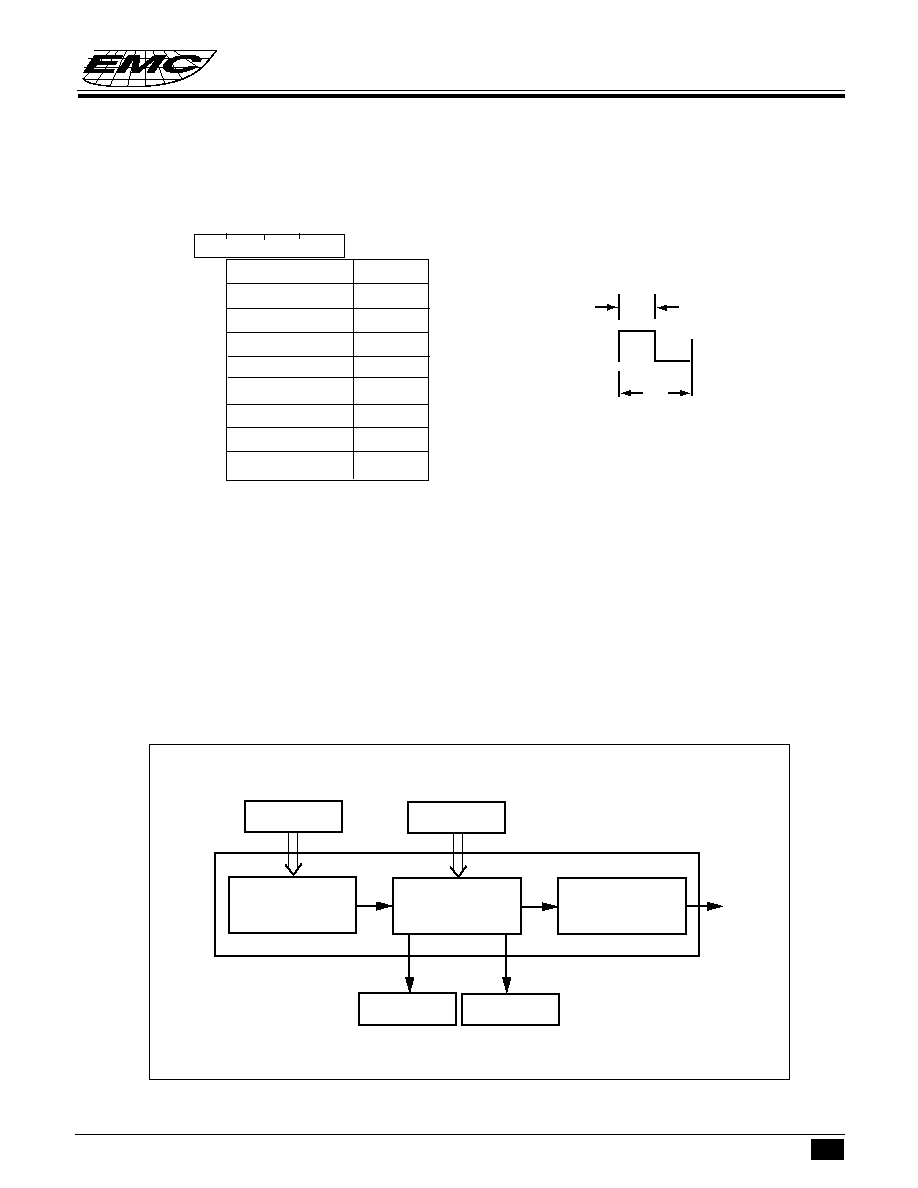
24
* This specification are subject to be changed without notice.
EM73982
EM73982
EM73982
EM73982
EM73982
4-BIT MICROCONTROLLER
4-BIT MICROCONTROLLER
4-BIT MICROCONTROLLER
4-BIT MICROCONTROLLER
4-BIT MICROCONTROLLER
11.30.2001
SPEECH SYNTHESIZER
SPEECH SYNTHESIZER
SPEECH SYNTHESIZER
SPEECH SYNTHESIZER
SPEECH SYNTHESIZER
BLOCK DIAGRAM
BLOCK DIAGRAM
BLOCK DIAGRAM
BLOCK DIAGRAM
BLOCK DIAGRAM
P6 Write
P5 Write
Speech ROM
Speech Decoder
7 Bits DAC
SPI
P6.3 read
Speech
Interrupt
Speech
Active
Set Speech Address
(Write 3times)
Set Sample Rate
Vo
tp
ts
tp=
60KHz
1
Volume control register
The are 8 levels of volume for sound generator. P17 is the volume control register.
Port17
Initial value : * 1111
3 2 1 0
*
VCR
VCR
ts/tp
1
1
1
8/8
1
1
0
7/8
1
0
1
6/7
1
0
0
5/8
0
1
1
4/8
0
1
0
3/8
0
0
1
2/8
0
0
0
1/8
PROGRAM EXAMPLE:
LDIA
#1001B ; basic frequency : 60 KHz tone output
OUTA
P30
LDIA
#0011B ; 600 Hz tone output
OUTA
P24
LDIA
#0001B
OUTA
P23

25
* This specification are subject to be changed without notice.
EM73982
EM73982
EM73982
EM73982
EM73982
4-BIT MICROCONTROLLER
4-BIT MICROCONTROLLER
4-BIT MICROCONTROLLER
4-BIT MICROCONTROLLER
4-BIT MICROCONTROLLER
11.30.2001
OPERATION PROCEDURE
OPERATION PROCEDURE
OPERATION PROCEDURE
OPERATION PROCEDURE
OPERATION PROCEDURE
(1) Write the speech wave file name to a document file (*.SET)
ex : Document filename : TEST.SET
TRY.WAV
GOOD.WAV
HURRY.WAV
:
:
(2) Run the speech convertind program address by SC982.exe, to get the speech section address table.
ex : Run C:\SC982 TEST.SET
:
:
Generated following files :
TEST.ADR
TEST.COD
TEST.SEG
(3) Write the TEST1.ADR in your program
ex : TEST.ASM
:
TRY
EQU 0040 H/40H
; Speech ROM Address get from TEST.ADR
GOOD
EQU 0D00H/40H
;
HURRY
EQU 19C0H/40H
;
:
:
LDIA
# TRY
; PLAY TRY.WAV
OUT
P6
LDIA
# TRY/10H
; Send the speech address by writing P6 three times
OUT
P6
LDIA
# TRY/100H
OUT
P6
LDIA
# 0011B
; set 8K sample rate and enable speech
OUT
P5
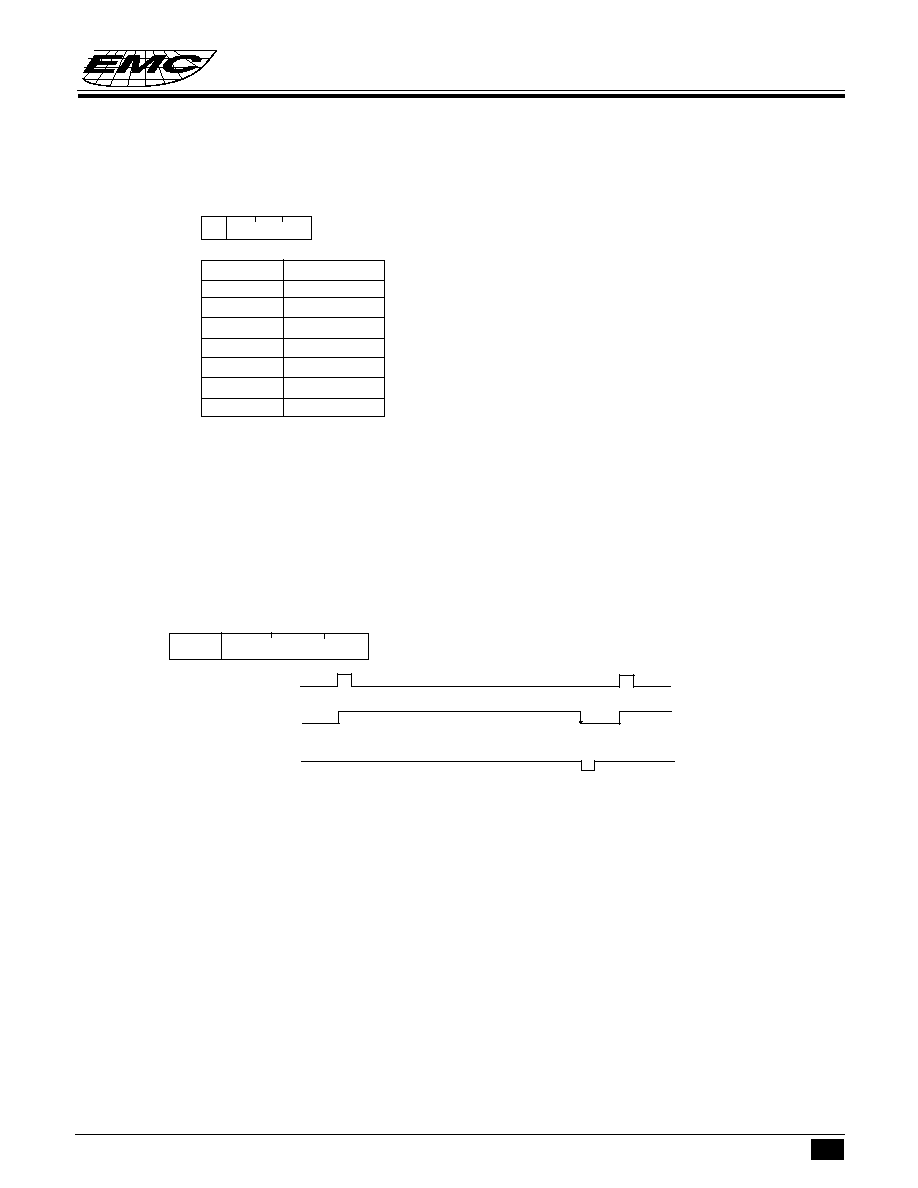
26
* This specification are subject to be changed without notice.
EM73982
EM73982
EM73982
EM73982
EM73982
4-BIT MICROCONTROLLER
4-BIT MICROCONTROLLER
4-BIT MICROCONTROLLER
4-BIT MICROCONTROLLER
4-BIT MICROCONTROLLER
11.30.2001
(4) Set the sample rate by P5
P5
3
2
1
0
SR
SR
Sample Rate
0
x
0
4K
0
0
1
5K
0
1
1
8K
1
0
0
10K
1
0
1
12K
1
1
0
15K
1
1
1
20K
(5) Control different voice by P6 ; if you want to stop the playing voice, you can output P6 by 0FH 3 times
:
:
LDIA
#0FH
OUT
P6
OUT
P6
OUT
P6
; Speech Stop
(9) Active flag for speech (P6.3 Read)
3
2
1
0
ACT
*
*
*
P6 Write
Port 6,3 ACT
SPI
ACT is high to low, the speech synthesizer can generate the speech ending interrupt.

27
* This specification are subject to be changed without notice.
EM73982
EM73982
EM73982
EM73982
EM73982
4-BIT MICROCONTROLLER
4-BIT MICROCONTROLLER
4-BIT MICROCONTROLLER
4-BIT MICROCONTROLLER
4-BIT MICROCONTROLLER
11.30.2001
RESET FUNCTION
RESET FUNCTION
RESET FUNCTION
RESET FUNCTION
RESET FUNCTION
When CPU in normal working condition and RESET pin holds in low level for three instruction cycles at least,
then CPU begins to initialize the whole internal states, and when RESET pin changes to high level, CPU begins
to work in normal condition.
The CPU internal state during reset condition is as following table :
Hardware condition in RESET (f1) state
Initial value
Program counter
0000h
Status flag
01h
Interrupt enable flip-flop ( EI )
00h
MASK0 ,1, 2, 3
00h
Interrupt latch ( IL )
00h
P3, P5, P6, P9, 16, 25, 27, 28, 29, 30
00h
P4, 8, 17, 23, 24
0Fh
XIN
Start oscillation
The RESET pin is a hysteresis input pin and it has a pull-up resistor available by mask option.
The simplest RESET circuit is connect RESET pin with a capacitor to V
SS
and a diode to V
DD
.
RESET
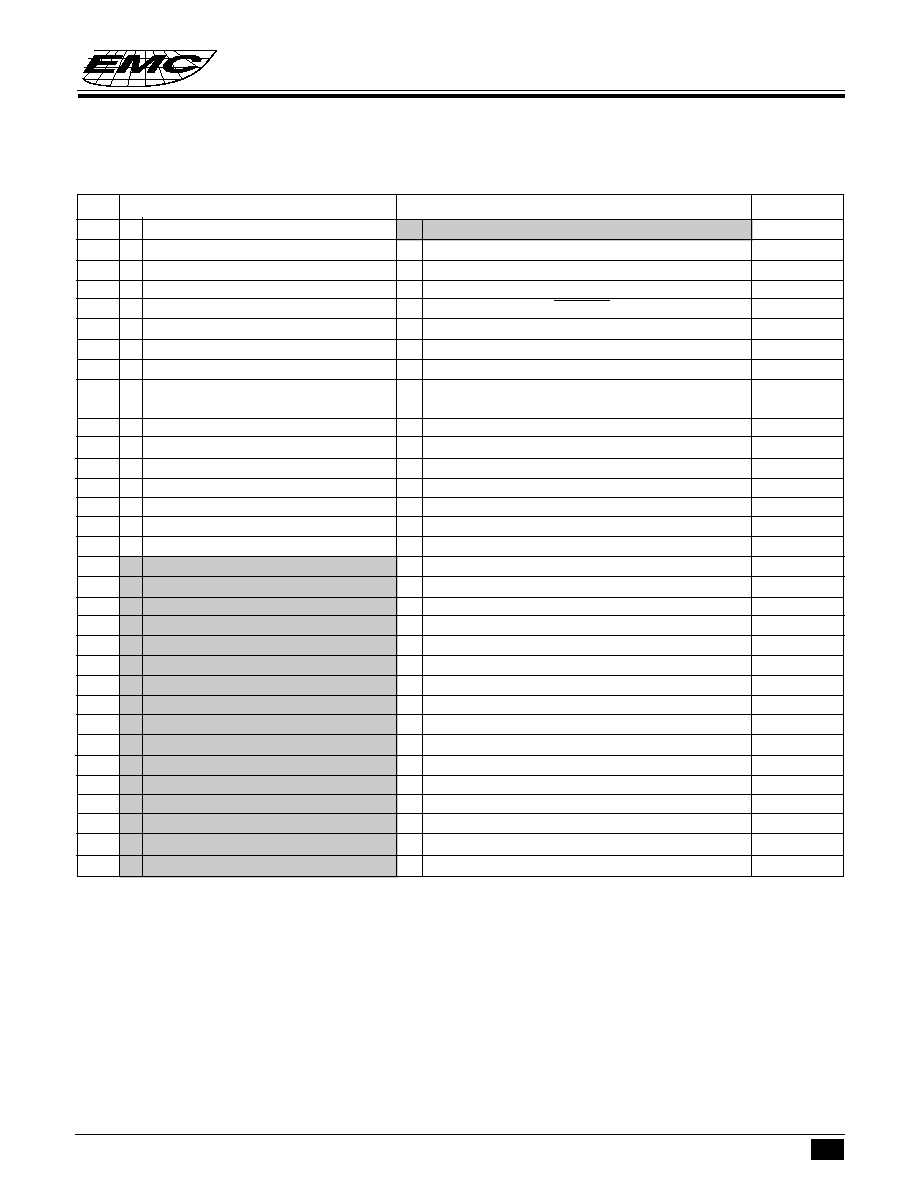
28
* This specification are subject to be changed without notice.
EM73982
EM73982
EM73982
EM73982
EM73982
4-BIT MICROCONTROLLER
4-BIT MICROCONTROLLER
4-BIT MICROCONTROLLER
4-BIT MICROCONTROLLER
4-BIT MICROCONTROLLER
11.30.2001
EM73982 I/O PORT DESCRIPTION :
EM73982 I/O PORT DESCRIPTION :
EM73982 I/O PORT DESCRIPTION :
EM73982 I/O PORT DESCRIPTION :
EM73982 I/O PORT DESCRIPTION :
Port
Port
Port
Port
Port
Input function
Input function
Input function
Input function
Input function
Output function
Output function
Output function
Output function
Output function
Note
Note
Note
Note
Note
0
E
Input port , wakeup function
1
--
--
2
--
--
3
--
I
P3(1..0) : ROM bank selection
4
E
input port
E
Output port, P4.0/SOUND
5
--
I
P5(0..3) : Speech sample rate
6
E
P6.3 : Speech Active pin
I
P6(0..3) : Speech ROM address
7
--
--
8
E
Input port, wakeup function,
E
Output port
external interrupt input
9
--
I
P9.3 : RAM bank selection
10
--
--
11
--
--
12
--
--
13
--
--
14
--
--
15
--
--
16
I
Sleep/Hold mode control register
17
I
Sound effect volume control register
18
--
19
--
20
--
21
--
22
--
23
I
Sound effect frequency register
low nibble
24
I
Sound effect command register
high nibble
25
I
Timebase control register
26
--
27
I
LCD control register
28
I
Timer/counter A control register
29
I
Timer/counter B control register
30
I
Sound effect command register
31
--
NOTE : E : external
I : internal
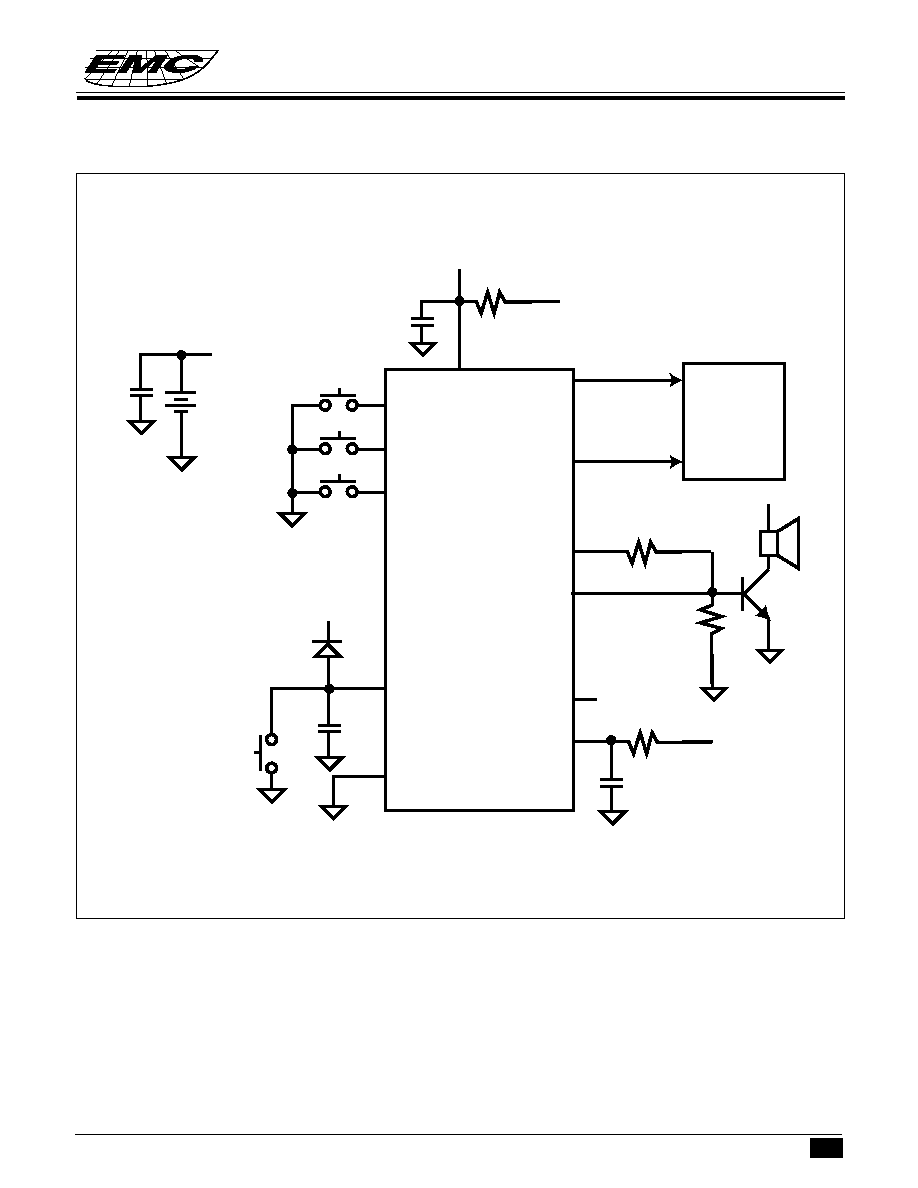
29
* This specification are subject to be changed without notice.
EM73982
EM73982
EM73982
EM73982
EM73982
4-BIT MICROCONTROLLER
4-BIT MICROCONTROLLER
4-BIT MICROCONTROLLER
4-BIT MICROCONTROLLER
4-BIT MICROCONTROLLER
11.30.2001
P0.0
P0.1
P0.2
RESET
VSS
SOUND
VO
XOUT
XIN
20PF
3.3K
0.1µF
0.1µF
0.1µF
SEG0~
SEG39
COM0~
COM7
LCD PANNEL
V
BAT
V
BAT
V
DD
EM73982
RESET
3V
100
1K
V
BAT
V
DD
6.2K
V
DD
V
DD
APPLICATION CIRCUIT
APPLICATION CIRCUIT
APPLICATION CIRCUIT
APPLICATION CIRCUIT
APPLICATION CIRCUIT
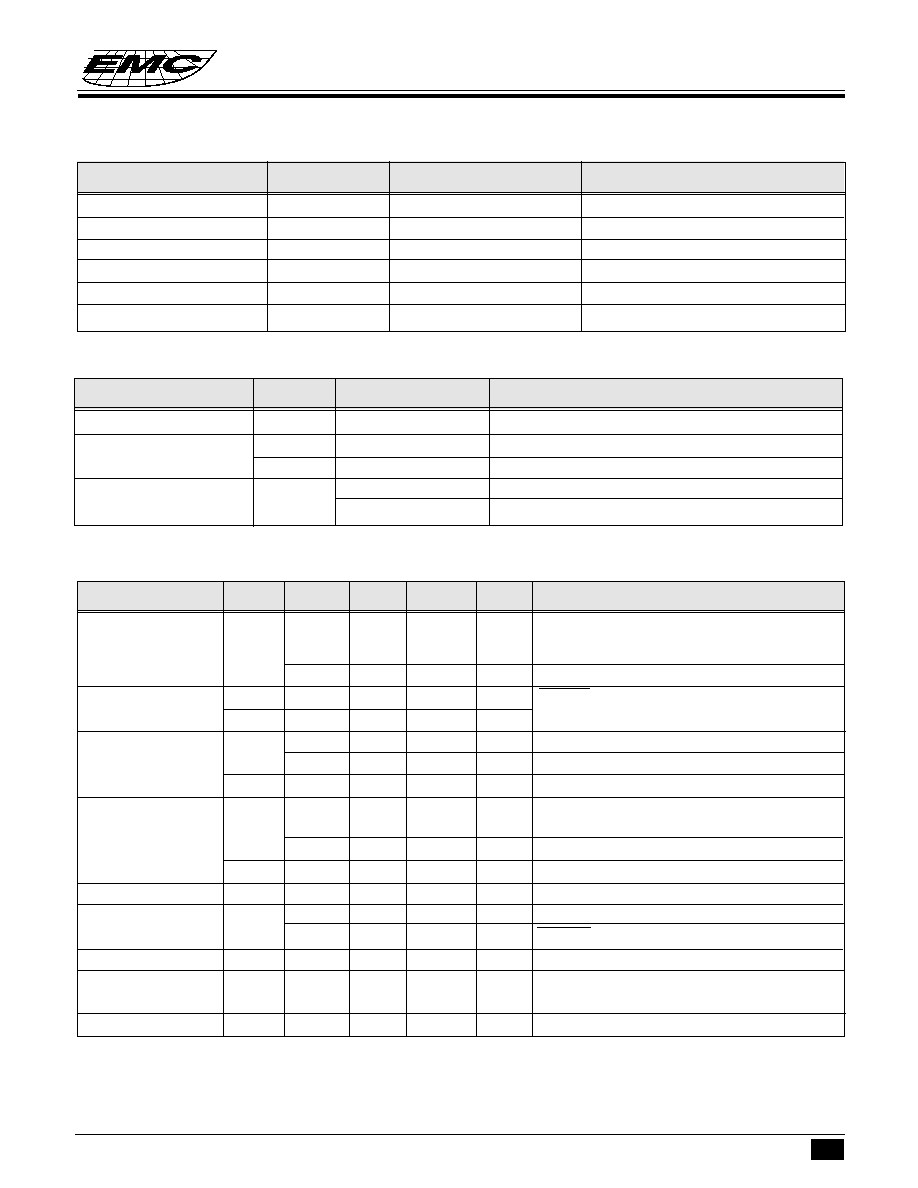
30
* This specification are subject to be changed without notice.
EM73982
EM73982
EM73982
EM73982
EM73982
4-BIT MICROCONTROLLER
4-BIT MICROCONTROLLER
4-BIT MICROCONTROLLER
4-BIT MICROCONTROLLER
4-BIT MICROCONTROLLER
11.30.2001
DC ELECTRICAL CHARACTERISTICS
DC ELECTRICAL CHARACTERISTICS
DC ELECTRICAL CHARACTERISTICS
DC ELECTRICAL CHARACTERISTICS
DC ELECTRICAL CHARACTERISTICS (V
DD
=3±0.3V, V
SS
=0V, T
OPR
=25
o
C)
Parameters Sym.
Parameters Sym.
Parameters Sym.
Parameters Sym.
Parameters Sym.
Min.
Min.
Min.
Min.
Min.
Typ.
Typ.
Typ.
Typ.
Typ.
Max.
Max.
Max.
Max.
Max.
Unit
Unit
Unit
Unit
Unit
Conditions
Conditions
Conditions
Conditions
Conditions
Supply current
I
DD
-
0.7
2
mA
V
DD
=3.3V,no load,Fc=4MHz
(RC osc : R=6.2K
, C=20pF)
-
0.1
1
µA
V
DD
=3.3V, sleep mode
Hysteresis voltage
V
HYS+
0.5V
DD
-
0.75V
DD
V
RESET, P0, P8
V
HYS-
0.2V
DD
-
0.4V
DD
V
Input current
I
IH
-
-
±1
µA
P0, RESET, V
DD
=3.3V,V
IH
=3.3/0V
-
-
±1
µA
Open-drain, V
DD
=3.3V,V
IH
=3.3/0V
I
IL
-
-
-500
µA
Push-pull, V
DD
=3.3V ,V
IL
=0.4V,except P4
Output voltage
V
O H
2.4
-
-
V
Push-pull, V
DD
=2.7V,P4(high current PMOS),
SOUND,I
OH
=-0.9mA
2.0
-
-
V
Push-pull, V
DD
=2.7V,others,I
OH
=-40µA
V
OL
-
-
0.3
V
V
DD
=2.7V,I
OL
=0.9mA
Leakage current
I
LO
-
-
1
µA
Open-drain, V
DD
=3.3V, V
O
=3.3V
Input resistor
R
IN
100
200
300
K
P0
300
600
900
K
RESET
Frequency stability
-
15
-
%
Fc=4MHz,RC osc,[F(3V)-F(2.4V)]/F(3V)
Frequency variation
-
20
-
%
Fc=4MHz, V
DD
=3V,RC osc,
[F(typical)-F(worse case)]/F(typical)
Output current of V
O
I
VO
2.0
3.0
4.0
mA
V
DD
=3V,V
O
=0.7V
RECOMMANDED OPERATING CONDITIONS
RECOMMANDED OPERATING CONDITIONS
RECOMMANDED OPERATING CONDITIONS
RECOMMANDED OPERATING CONDITIONS
RECOMMANDED OPERATING CONDITIONS
Items
Items
Items
Items
Items
Sym.
Sym.
Sym.
Sym.
Sym.
Ratings
Ratings
Ratings
Ratings
Ratings
Condition
Condition
Condition
Condition
Condition
Supply Voltage
V
D D
2.4V to 5.5V
Input Voltage
V
IH
0.90xV
DD
to V
DD
V
IL
0V to 0.10xV
DD
Operating Frequency
F
C
480K to 4MHz
CLK (RC osc)
480K to 4.19MHz
XIN,XOUT (crystal osc)
ABSOLUTE MAXIMUM RATINGS
ABSOLUTE MAXIMUM RATINGS
ABSOLUTE MAXIMUM RATINGS
ABSOLUTE MAXIMUM RATINGS
ABSOLUTE MAXIMUM RATINGS
Items
Items
Items
Items
Items
Sym.
Sym.
Sym.
Sym.
Sym.
Ratings
Ratings
Ratings
Ratings
Ratings
Conditions
Conditions
Conditions
Conditions
Conditions
Supply Voltage
V
DD
-0.5V to 6V
Input Voltage
V
IN
-0.5V to V
DD
+0.5V
Output Voltage
V
O
-0.5V to V
DD
+0.5V
Power Dissipation
P
D
300mW
T
OPR
=50
o
C
Operating Temperature
T
OPR
0
o
C to 50
o
C
Storage Temperature
T
STG
-55
o
C to 125
o
C

31
* This specification are subject to be changed without notice.
EM73982
EM73982
EM73982
EM73982
EM73982
4-BIT MICROCONTROLLER
4-BIT MICROCONTROLLER
4-BIT MICROCONTROLLER
4-BIT MICROCONTROLLER
4-BIT MICROCONTROLLER
11.30.2001
(V
DD
=4.5±0.5V, V
SS
=0V, T
OPR
=25
o
C)
Parameters Sym.
Parameters Sym.
Parameters Sym.
Parameters Sym.
Parameters Sym.
Min.
Min.
Min.
Min.
Min.
Typ.
Typ.
Typ.
Typ.
Typ.
Max.
Max.
Max.
Max.
Max.
Unit
Unit
Unit
Unit
Unit
Conditions
Conditions
Conditions
Conditions
Conditions
Supply current
I
DD
-
4.5
5.5
mA
V
DD
=5V, no load, Fc=4MHz(crystal osc)
-
1.5
2
mA
V
DD
=5V, no load, Fc=4MHz(RC osc :
R=7.5K
, C=20pF)
-
0.1
1
µ
A
V
DD
=5V, sleep mode
Hysteresis voltage
V
HYS+
0.5V
DD
-
0.75V
DD
V
RESET, P0, P8
V
HYS-
0.2V
DD
-
0.4V
DD
V
Input current
I
IH
-
-
±1
µ
A
P0, RESET, V
DD
=5V, V
IH
=5/0V
-
-
±1
µ
A
Open-drain, V
DD
=5V, V
IH
=5/0V
I
IL
-
-
-1
mA
Push-pull, V
DD
=5V ,V
IL
=0.4V, except P4
Output voltage
V
O H
3.0
-
-
V
Push-pull, P4(high current PMOS), SOUND
V
DD
=4V, I
OH
=-4mA
2.4
-
-
V
Push-pull, P4(low current PMOS), P8
V
DD
=4V, I
OH
=-200
µ
A
V
O L
-
-
1.0
V
V
DD
=4V, I
OL
=4mA
Leakage current
I
LO
-
-
1
µ
A
Open-drain, V
DD
=5V, V
O
=5V
Input resistor
R
IN
30
90
150
K
P0
100
300
450
K
RESET
Frequency stability
-
10
-
%
Fc=4MHz,RC osc,[F(4.5V)-F(3.6V)]/F(4.5V)
Frequency variation
-
20
-
%
Fc=4MHz, V
DD
=4.5V,RC osc,
[F(typical)-F(worse case)]/F(typical)
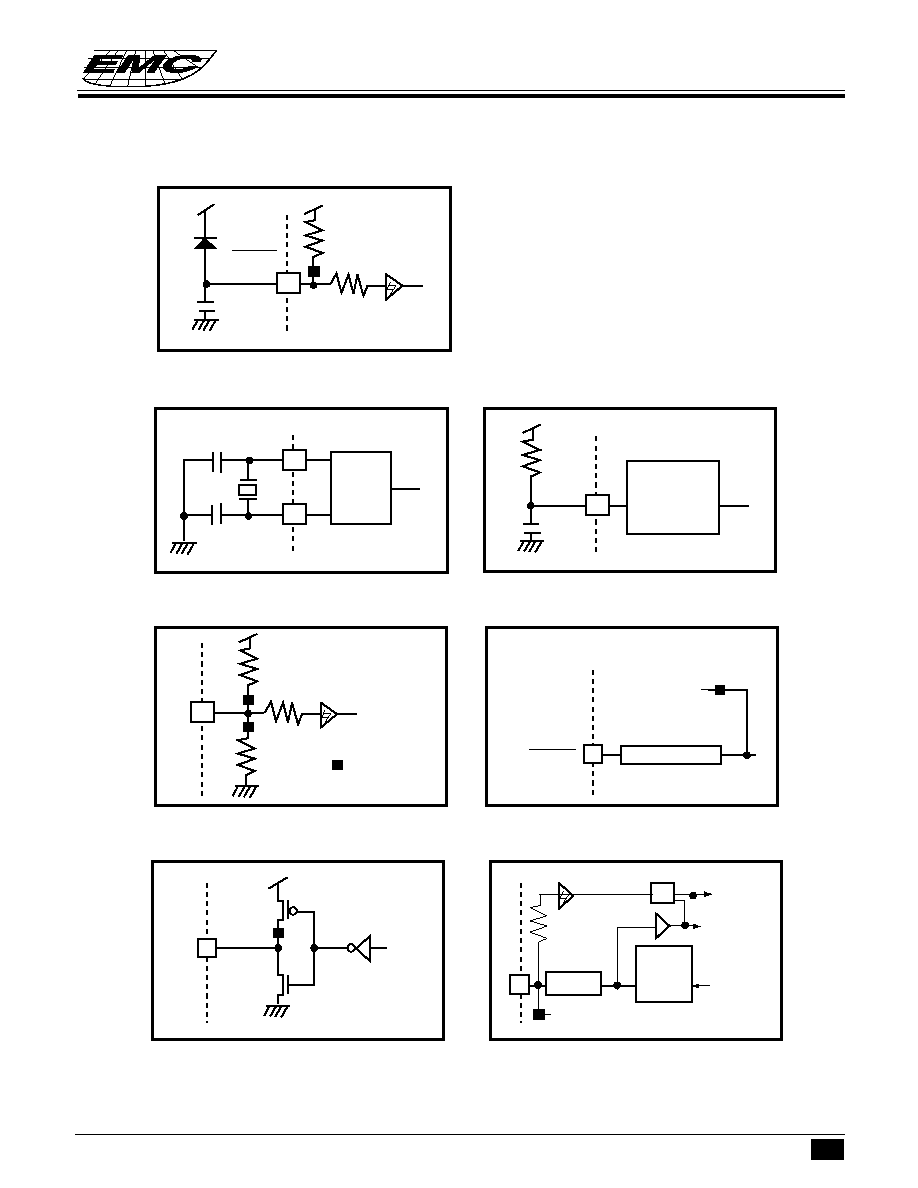
32
* This specification are subject to be changed without notice.
EM73982
EM73982
EM73982
EM73982
EM73982
4-BIT MICROCONTROLLER
4-BIT MICROCONTROLLER
4-BIT MICROCONTROLLER
4-BIT MICROCONTROLLER
4-BIT MICROCONTROLLER
11.30.2001
RESET
mask option
XIN
XOUT
Crystal
Osc.
mask option
: mask option
P0/WAKEUP TYPE
INPUT-A
XIN
WAKEUP function
mask option
RC Osc.
(comparator)
TYPE I/O
Output
data
latch
Input
data
Output
data
path B
path A
SEL
Special function
control input
WAKEUP function
mask option
RESET PIN TYPE
RESET PIN TYPE
RESET PIN TYPE
RESET PIN TYPE
RESET PIN TYPE
TYPE RESET-A
OSCILLATION PIN TYPE
OSCILLATION PIN TYPE
OSCILLATION PIN TYPE
OSCILLATION PIN TYPE
OSCILLATION PIN TYPE
TYPE OSC-A
TYPE OSC-C
INPUT PIN TYPE
INPUT PIN TYPE
INPUT PIN TYPE
INPUT PIN TYPE
INPUT PIN TYPE
TYPE INPUT-A
TYPE INPUT-B
I/O PIN TYPE
I/O PIN TYPE
I/O PIN TYPE
I/O PIN TYPE
I/O PIN TYPE
TYPE I/O
TYPE I/O-L

33
* This specification are subject to be changed without notice.
EM73982
EM73982
EM73982
EM73982
EM73982
4-BIT MICROCONTROLLER
4-BIT MICROCONTROLLER
4-BIT MICROCONTROLLER
4-BIT MICROCONTROLLER
4-BIT MICROCONTROLLER
11.30.2001
TYPE I/O-N
TYPE I/O-N
TYPE I/O-N
TYPE I/O-N
TYPE I/O-N
TYPE I/O-O
TYPE I/O-O
TYPE I/O-O
TYPE I/O-O
TYPE I/O-O
Path A :
For set and clear bit of port instructions, data goes through path A from output data latch to CPU.
Path B :
For input and test instructions, data from output pin go through path B to CPU and the output data latch
will be set to high.
Input
data
Output
data
path B
path A
TYPE I/O-N
Output
data
latch
Special function
output
: mask option
: mask option
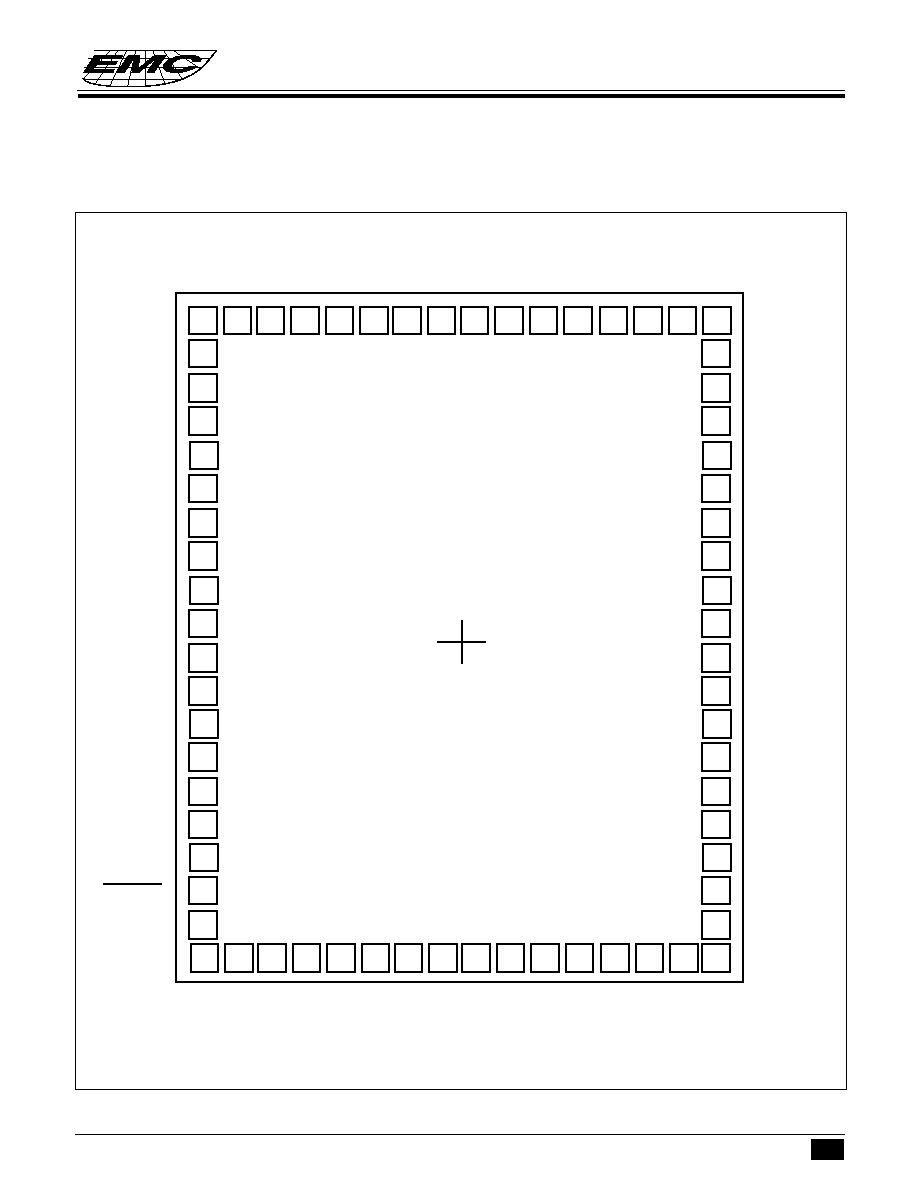
34
* This specification are subject to be changed without notice.
EM73982
EM73982
EM73982
EM73982
EM73982
4-BIT MICROCONTROLLER
4-BIT MICROCONTROLLER
4-BIT MICROCONTROLLER
4-BIT MICROCONTROLLER
4-BIT MICROCONTROLLER
11.30.2001
PAD DIAGRAM
PAD DIAGRAM
PAD DIAGRAM
PAD DIAGRAM
PAD DIAGRAM
1
2
3
4
5
6
7
8
9
10
11
12
13
14
15
16
17
18
19
20
54
53
52
51
50
49
48
47
46
45
44
43
42
41
40
39
38
37
36
35
21 22 23 24 25 26 27 28 29 30 31 32 33 34
68 67 66 65 64 63 62 61 60 59 58 57 56 55
SEG22
SEG23
SEG24
SEG25
SEG26
SEG27
SEG28
SEG29
SEG30
SEG31
SEG32
SEG33
SEG34
SEG35
SEG36
SEG37
SEG38
SEG39
COM0
COM1
SEG8
ESG9
SEG10
SEG11
ESG12
SEG13
SEG14
SEG15
SEG16
SEG17
SEG18
SEG19
SEG20
SEG21
SEG7
SEG6
SEG5
SEG4
SEG3
SEG2
SEG1
SEG0
VSS
P8.0
P8.1
P8.2
P8.3
P0.0
P0.1
P0.2
P0.3
RESET
TEST
XIN
XOUT
VDD
VO
SOUND
P4.0
P4.1
P4.2
P4.3
COM7
COM6
COM5
COM4
COM3
COM2
COM1
(0,0)
EM73982
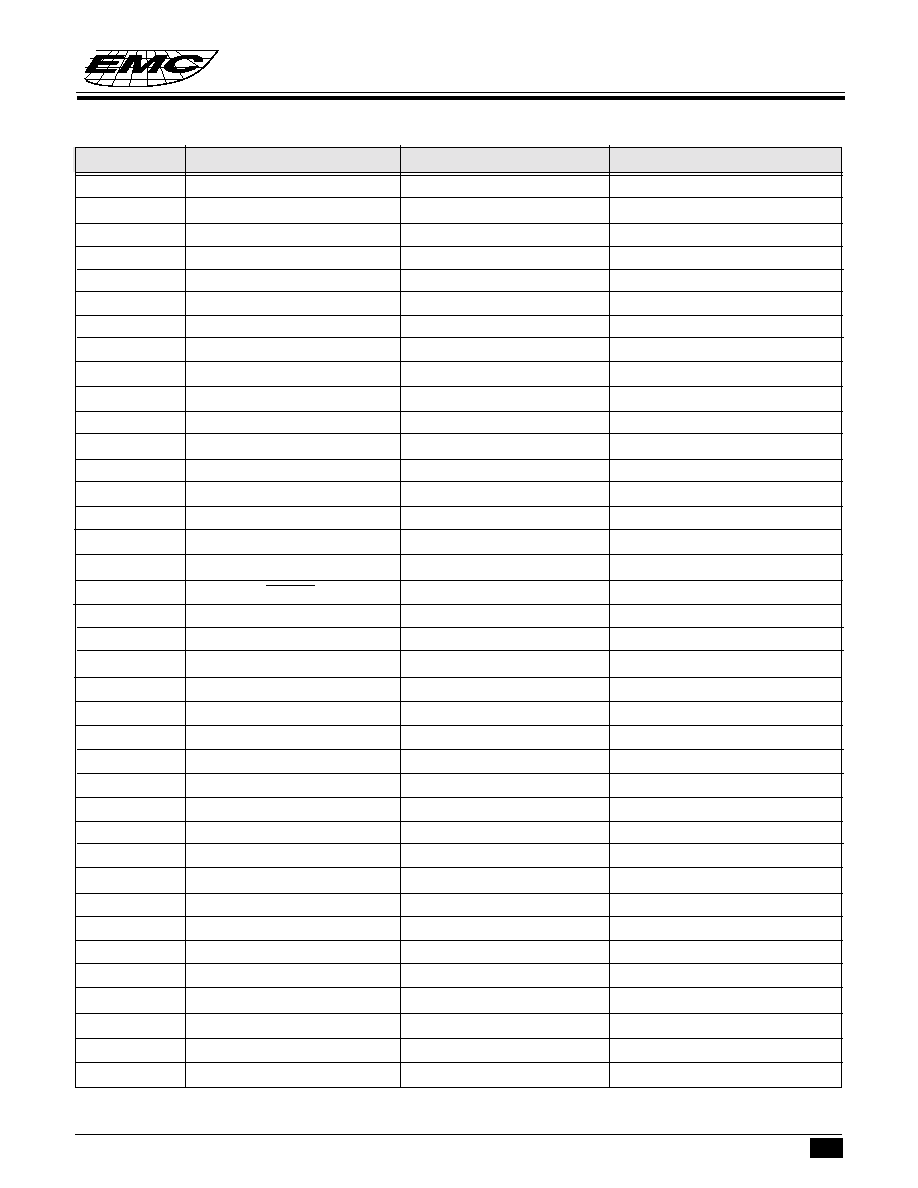
35
* This specification are subject to be changed without notice.
EM73982
EM73982
EM73982
EM73982
EM73982
4-BIT MICROCONTROLLER
4-BIT MICROCONTROLLER
4-BIT MICROCONTROLLER
4-BIT MICROCONTROLLER
4-BIT MICROCONTROLLER
11.30.2001
Pad No.
Pad No.
Pad No.
Pad No.
Pad No.
Symbol
Symbol
Symbol
Symbol
Symbol
X
X
X
X
X
Y
Y
Y
Y
Y
1
SEG7
-839.6
1063.4
2
SEG6
-839.6
952.9
3
SEG5
-839.6
842.5
4
SEG4
-839.6
732.0
5
SEG3
-839.6
621.6
6
SEG2
-839.6
511.1
7
SEG1
-839.6
400.6
8
SEG0
-828.2
290.2
9
VSS
-828.2
179.7
10
P8.0
-834.7
59.9
11
P8.1
-834.7
-52.1
12
P8.2
-834.7
-164.2
13
P8.3
-834.7
-276.2
14
P0.0
-834.7
-388.3
15
P0.1
-834.7
-500.3
16
P0.2
-834.7
-612.4
17
P0.3
-834.7
-724.5
18
RESET
-834.7
-836.5
19
TEST
-839.6
-948.1
20
XIN
-839.6
-1060.2
21
XOUT
-719.9
-1049.6
22
VDD
-605.6
-1035.2
23
VO
-489.9
-1044.7
24
SOUND
-374.4
-1044.7
25
P4.0
-262.4
-1044.7
26
P4.1
-150.3
-1044.7
27
P4.2
-38.3
-1044.7
28
P4.3
73.8
-1044.7
29
COM7
185.9
-1049.6
30
COM6
296.3
-1049.6
31
COM5
406.8
-1049.6
32
COM4
517.2
-1049.6
33
COM3
627.7
-1049.6
34
COM2
738.2
-1049.6
35
COM1
848.6
-1049.6
36
COM0
839.6
-929.9
37
SEG39
839.6
-819.5
38
SEG38
839.6
-709.0
Chip Size : 2000 x 2420 UM.
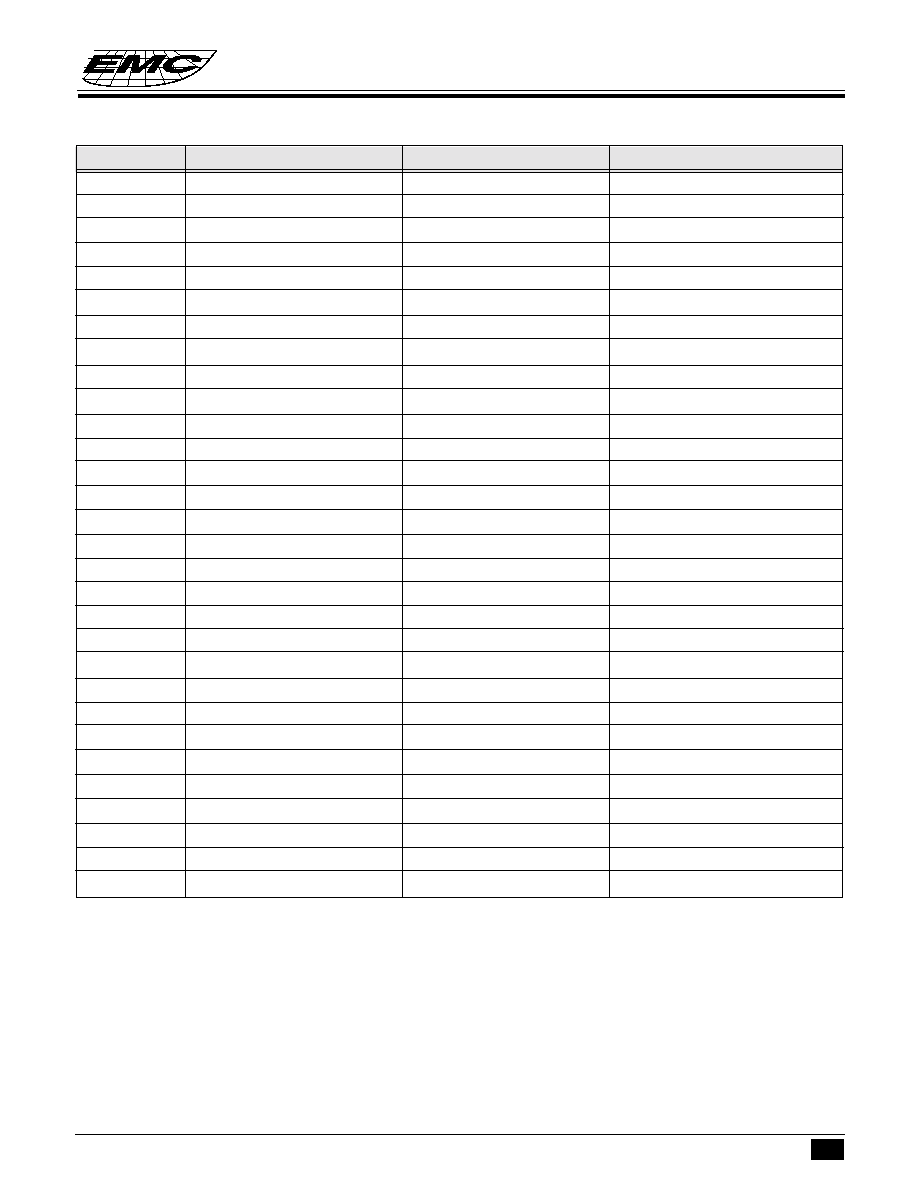
36
* This specification are subject to be changed without notice.
EM73982
EM73982
EM73982
EM73982
EM73982
4-BIT MICROCONTROLLER
4-BIT MICROCONTROLLER
4-BIT MICROCONTROLLER
4-BIT MICROCONTROLLER
4-BIT MICROCONTROLLER
11.30.2001
Pad No.
Pad No.
Pad No.
Pad No.
Pad No.
Symbol
Symbol
Symbol
Symbol
Symbol
X
X
X
X
X
Y
Y
Y
Y
Y
39
SEG37
839.6
-598.5
40
SEG36
839.6
-488.1
41
SEG35
839.6
-377.6
42
SEG34
839.6
-267.2
43
SEG33
839.6
-156.7
44
SEG32
839.6
-46.2
45
SEG31
839.6
64.2
46
SEG30
839.6
174.7
47
SEG29
839.6
285.1
48
SEG28
839.6
395.6
49
SEG27
839.6
506.1
50
SEG26
839.6
616.5
51
SEG25
839.6
727.0
52
SEG24
839.6
837.4
53
SEG23
839.6
947.9
54
SEG22
839.6
1058.4
55
SEG21
718.0
1049.4
56
SEG20
607.5
1049.4
57
SEG19
497.1
1049.4
58
SEG18
386.6
1049.4
59
SEG17
276.2
1049.4
60
SEG16
165.7
1049.4
61
SEG15
55.2
1049.4
62
SEG14
-55.2
1049.4
63
SEG13
-165.7
1049.4
64
SEG12
-276.1
1049.4
65
SEG11
-386.6
1049.4
66
SEG10
-497.1
1049.4
67
SEG9
-607.5
1049.4
68
SEG8
-718.0
1049.4
NOTE : Unit :
µ
m
For PCB layout, IC substrate must be floated or connected to Vss.

37
* This specification are subject to be changed without notice.
EM73982
EM73982
EM73982
EM73982
EM73982
4-BIT MICROCONTROLLER
4-BIT MICROCONTROLLER
4-BIT MICROCONTROLLER
4-BIT MICROCONTROLLER
4-BIT MICROCONTROLLER
11.30.2001
INSTRUCTION TABLE
INSTRUCTION TABLE
INSTRUCTION TABLE
INSTRUCTION TABLE
INSTRUCTION TABLE
(1) Data Transfer
(1) Data Transfer
(1) Data Transfer
(1) Data Transfer
(1) Data Transfer
Mnemonic Object code ( binary )
Mnemonic Object code ( binary )
Mnemonic Object code ( binary )
Mnemonic Object code ( binary )
Mnemonic Object code ( binary )
Operation description
Operation description
Operation description
Operation description
Operation description
Byte
Byte
Byte
Byte
Byte
Cycle
Cycle
Cycle
Cycle
Cycle
Flag
Flag
Flag
Flag
Flag
C
C
C
C
C
Z
Z
Z
Z
Z
S
S
S
S
S
LDA x
0110 1010 xxxx xxxx
Acc
RAM[x]
2
2
-
Z
1
LDAM
0101 1010
Acc
RAM[HL]
1
1
-
Z
1
LDAX
0110 0101
Acc
ROM[DP]
L
1
2
-
Z
1
LDAXI
0110 0111
Acc
ROM[DP]
H
,DP+1
1
2
-
Z
1
LDH #k
1001 kkkk
HR
k
1
1
-
-
1
LDHL x
0100 1110 xxxx xx00
LR
RAM[x],HR
RAM[x+1] 2
2
-
-
1
LDIA #k
1101 kkkk
Acc
k
1
1
-
Z
1
LDL #k
1000 kkkk
LR
k
1
1
-
-
1
STA x
0110 1001 xxxx xxxx
RAM[x]
Acc
2
2
-
-
1
STAM
0101 1001
RAM[HL]
Acc
1
1
-
-
1
STAMD 0111 1101
RAM[HL]
Acc, LR-1
1
1
-
Z
C
STAMI
0111 1111
RAM[HL]
Acc, LR+1
1
1
-
Z
C'
STD #k,y
0100 1000 kkkk yyyy
RAM[y]
k
2
2
-
-
1
STDMI #k
1010 kkkk
RAM[HL]
k, LR+1
1
1
-
Z
C'
THA
0111 0110
Acc
HR
1
1
-
Z
1
TLA
0111 0100
Acc
LR
1
1
-
Z
1
(2) Rotate
(2) Rotate
(2) Rotate
(2) Rotate
(2) Rotate
Mnemonic Object code ( binary )
Mnemonic Object code ( binary )
Mnemonic Object code ( binary )
Mnemonic Object code ( binary )
Mnemonic Object code ( binary )
Operation description
Operation description
Operation description
Operation description
Operation description
Byte
Byte
Byte
Byte
Byte
Cycle
Cycle
Cycle
Cycle
Cycle
Flag
Flag
Flag
Flag
Flag
C
C
C
C
C
Z
Z
Z
Z
Z
S
S
S
S
S
RLCA 0101 0000
CF
Acc
1
1
C
Z
C'
RRCA 0101 0001
CF
Acc
1
1
C
Z
C'
(3) Arithmetic operation
3) Arithmetic operation
3) Arithmetic operation
3) Arithmetic operation
3) Arithmetic operation
Mnemonic Object code ( binary )
Mnemonic Object code ( binary )
Mnemonic Object code ( binary )
Mnemonic Object code ( binary )
Mnemonic Object code ( binary )
Operation description
Operation description
Operation description
Operation description
Operation description
Byte
Byte
Byte
Byte
Byte
Cycle
Cycle
Cycle
Cycle
Cycle
Flag
Flag
Flag
Flag
Flag
C
C
C
C
C
Z
Z
Z
Z
Z
S
S
S
S
S
ADCAM
0111 0000
Acc
Acc + RAM[HL] + CF
1
1
C
Z
C'
ADD
#k,y
0100 1001 kkkk yyyy
RAM[y]
RAM[y] +k
2
2
-
Z
C'
ADDA #k
0110 1110 0101 kkkk
Acc
Acc+k
2
2
-
Z
C'
ADDAM
0111 0001
Acc
Acc + RAM[HL]
1
1
-
Z
C'
ADDH #k
0110 1110 1001 kkkk
HR
HR+k
2
2
-
Z
C'
ADDL
#k
0110 1110 0001 kkkk
LR
LR+k
2
2
-
Z
C'
ADDM #k
0110 1110 1101 kkkk
RAM[HL]
RAM[HL] +k
2
2
-
Z
C'
DECA
0101 1100
Acc
Acc-1
1
1
-
Z
C
DECL
0111 1100
LR
LR-1
1
1
-
Z
C
DECM
0101 1101
RAM[HL]
RAM[HL] -1
1
1
-
Z
C
INCA
0101 1110
Acc
Acc + 1
1
1
-
Z
C'
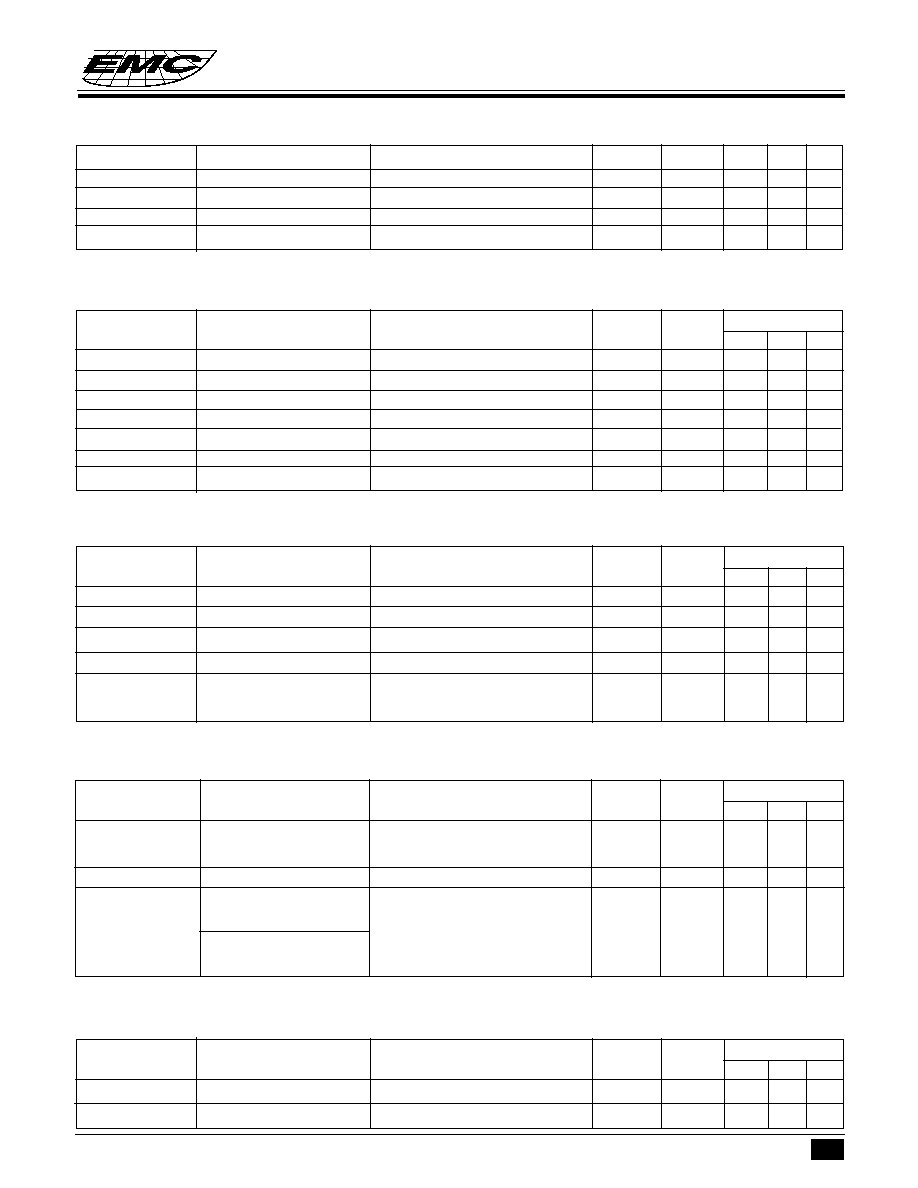
38
* This specification are subject to be changed without notice.
EM73982
EM73982
EM73982
EM73982
EM73982
4-BIT MICROCONTROLLER
4-BIT MICROCONTROLLER
4-BIT MICROCONTROLLER
4-BIT MICROCONTROLLER
4-BIT MICROCONTROLLER
11.30.2001
INCL
0111 1110
LR
LR + 1
1
1
-
Z
C'
INCM
0101 1111
RAM[HL]
RAM[HL]+1
1
1
-
Z
C'
SUBA
#k
0110 1110 0111 kkkk
Acc
k-Acc
2
2
-
Z
C
SBCAM
0111 0010
Acc
RAM[HLl - Acc - CF'
1
1
C
Z
C
SUBM #k
0110 1110 1111 kkkk
RAM[HL]
k - RAM[HL]
2
2
-
Z
C
((
((
(
4) Logical operation
4) Logical operation
4) Logical operation
4) Logical operation
4) Logical operation
Mnemonic Object code ( binary )
Mnemonic Object code ( binary )
Mnemonic Object code ( binary )
Mnemonic Object code ( binary )
Mnemonic Object code ( binary )
Operation description
Operation description
Operation description
Operation description
Operation description
Byte
Byte
Byte
Byte
Byte
Cycle
Cycle
Cycle
Cycle
Cycle
Flag
Flag
Flag
Flag
Flag
C
C
C
C
C
Z
Z
Z
Z
Z
S
S
S
S
S
ANDA #k
0110 1110 0110 kkkk Acc
Acc&k
2
2
-
Z
Z'
ANDAM
0111 1011
Acc
Acc & RAM[HL]
1
1
-
Z
Z'
ANDM #k
0110 1110 1110 kkkk RAM[HL]
RAM[HL]&k
2
2
-
Z
Z'
ORA
#k
0110 1110 0100 kkkk Acc
Acc k
2
2
-
Z
Z'
ORAM
0111 1000
Acc
Acc RAM[HL]
1
1
-
Z
Z'
ORM
#k
0110 1110 1100 kkkk RAM[HL]
RAM[HL] k
2
2
-
Z
Z'
XORAM
0111 1001
Acc
Acc^RAM[HL]
1
1
-
Z
Z'
(5) Exchange
(5) Exchange
(5) Exchange
(5) Exchange
(5) Exchange
Mnemonic Object code ( binary )
Mnemonic Object code ( binary )
Mnemonic Object code ( binary )
Mnemonic Object code ( binary )
Mnemonic Object code ( binary )
Operation description
Operation description
Operation description
Operation description
Operation description
Byte
Byte
Byte
Byte
Byte
Cycle
Cycle
Cycle
Cycle
Cycle
Flag
Flag
Flag
Flag
Flag
C
C
C
C
C
Z
Z
Z
Z
Z
S
S
S
S
S
EXA
x
0110 1000 xxxx xxxx Acc
RAM[x]
2
2
-
Z
1
EXAH
0110 0110
Acc
HR
1
2
-
Z
1
EXAL
0110 0100
Acc
LR
1
2
-
Z
1
EXAM
0101 1000
Acc
RAM[HL]
1
1
-
Z
1
EXHL x
0100 1100 xxxx xx00
LR
RAM[x],
HR
RAM[x+1]
2
2
-
-
1
(6) Branch
(6) Branch
(6) Branch
(6) Branch
(6) Branch
Mnemonic Object code ( binary )
Mnemonic Object code ( binary )
Mnemonic Object code ( binary )
Mnemonic Object code ( binary )
Mnemonic Object code ( binary )
Operation description
Operation description
Operation description
Operation description
Operation description
Byte
Byte
Byte
Byte
Byte
Cycle
Cycle
Cycle
Cycle
Cycle
Flag
Flag
Flag
Flag
Flag
C
C
C
C
C
Z
Z
Z
Z
Z
S
S
S
S
S
SBR a
00aa aaaa
If SF=1 then PC
PC
12-6
.a
5-0
1
1
-
-
1
else null
LBR a 1100 aaaa aaaa aaaa
If SF= 1 then PC
a else null
2
2
-
-
1
SLBR a
0101 0101 1100 aaaa
If SF=1 then PC
a else null
3
3
-
-
1
aaaa aaaa
(a:1000~1FFFh)
0101 0111 1100 aaaa
aaaa aaaa
(a:0000~0FFFh)
(7) Compare
(7) Compare
(7) Compare
(7) Compare
(7) Compare
Mnemonic Object code ( binary )
Mnemonic Object code ( binary )
Mnemonic Object code ( binary )
Mnemonic Object code ( binary )
Mnemonic Object code ( binary )
Operation description
Operation description
Operation description
Operation description
Operation description
Byte
Byte
Byte
Byte
Byte
Cycle
Cycle
Cycle
Cycle
Cycle
Flag
Flag
Flag
Flag
Flag
C
C
C
C
C
Z
Z
Z
Z
Z
S
S
S
S
S
CMP
#k,y 0100 1011 kkkk yyyy
k-RAM[y]
2
2
C
Z
Z'
CMPA x
0110 1011 xxxx xxxx
RAM[x]-Acc
2
2
C
Z
Z'
- -
- -
- -

39
* This specification are subject to be changed without notice.
EM73982
EM73982
EM73982
EM73982
EM73982
4-BIT MICROCONTROLLER
4-BIT MICROCONTROLLER
4-BIT MICROCONTROLLER
4-BIT MICROCONTROLLER
4-BIT MICROCONTROLLER
11.30.2001
(8) Bit manipulation
(8) Bit manipulation
(8) Bit manipulation
(8) Bit manipulation
(8) Bit manipulation
Mnemonic Object code ( binary )
Mnemonic Object code ( binary )
Mnemonic Object code ( binary )
Mnemonic Object code ( binary )
Mnemonic Object code ( binary )
Operation description
Operation description
Operation description
Operation description
Operation description
Byte
Byte
Byte
Byte
Byte
Cycle
Cycle
Cycle
Cycle
Cycle
Flag
Flag
Flag
Flag
Flag
C
C
C
C
C
Z
Z
Z
Z
Z
S
S
S
S
S
CLM
b
1111 00bb
RAM[HL]
b
0
1
1
-
-
1
CLP
p,b
0110 1101 11bb pppp
PORT[p]
b
0
2
2
-
-
1
CLPL
0110 0000
PORT[LR
3-2
+4]
LR
1-0
0
1
2
-
-
1
CLR y,b
0110 1100 11bb yyyy
RAM[y]
b
0
2
2
-
-
1
SEM
b
1111 01bb
RAM[HL]
b
1
1
1
-
-
1
SEP
p,b
0110 1101 01bb pppp
PORT[p]
b
1
2
2
-
-
1
SEPL
0110 0010
PORT[LR
3-2
+4]
LR
l-0
1
1
2
-
-
1
SET
y,b
0110 1100 01bb yyyy
RAM[y]
b
1
2
2
-
-
1
TF
y,b
0110 1100 00bb yyyy
SF
RAM[y]
b
'
2
2
-
-
*
TFA
b
1111 10bb
SF
Acc
b
'
1
1
-
-
*
TFM b
1111 11bb
SF
RAM[HL]
b
'
1
1
-
-
*
TFP
p,b
0110 1101 00bb pppp
SF
PORT[p]
b
'
2
2
-
-
*
TFPL
0110 0001
SF
PORT[LR
3-2
+4]
LR
1-0
'
1
2
-
-
*
TT
y,b
0110 1100 10bb yyyy
SF
RAM[y]
b
2
2
-
-
*
TTP
p,b
0110 1101 10bb pppp
SF
PORT[p]
b
2
2
-
-
*
(9) Subroutine
(9) Subroutine
(9) Subroutine
(9) Subroutine
(9) Subroutine
Mnemonic Object code ( binary )
Mnemonic Object code ( binary )
Mnemonic Object code ( binary )
Mnemonic Object code ( binary )
Mnemonic Object code ( binary )
Operation description
Operation description
Operation description
Operation description
Operation description
Byte
Byte
Byte
Byte
Byte
Cycle
Cycle
Cycle
Cycle
Cycle
Flag
Flag
Flag
Flag
Flag
C
C
C
C
C
Z
Z
Z
Z
Z
S
S
S
S
S
LCALL a
0100 0aaa aaaa aaaa
STACK[SP]
PC,
2
2
-
-
-
SP
SP -1, PC
a
SCALL a
1110 nnnn
STACK[SP]
PC,
1
2
-
-
-
SP
SP - 1, PC
a, a = 8n + 6
(n
=115
),0086h (n = 0)
RET
0100 1111
SP
SP + 1, PC
STACK[SP]
1
2
-
-
-
(10) Input/output
(10) Input/output
(10) Input/output
(10) Input/output
(10) Input/output
Mnemonic Object code ( binary )
Mnemonic Object code ( binary )
Mnemonic Object code ( binary )
Mnemonic Object code ( binary )
Mnemonic Object code ( binary )
Operation description
Operation description
Operation description
Operation description
Operation description
Byte
Byte
Byte
Byte
Byte
Cycle
Cycle
Cycle
Cycle
Cycle
Flag
Flag
Flag
Flag
Flag
C
C
C
C
C
Z
Z
Z
Z
Z
S
S
S
S
S
INA p
0110 1111 0100 pppp
Acc
PORT[p]
2
2
-
Z
Z'
INM p
0110 1111 1100 pppp
RAM[HL]
PORT[p]
2
2
-
-
Z'
OUT #k,p
0100 1010 kkkk pppp
PORT[p]
k
2
2
-
-
1
OUTA p
0110 1111 000p pppp
PORT[p]
Acc
2
2
-
-
1
OUTM p
0110 1111 100p pppp
PORT[p]
RAM[HL]
2
2
-
-
1
Mnemonic Object code ( binary )
Mnemonic Object code ( binary )
Mnemonic Object code ( binary )
Mnemonic Object code ( binary )
Mnemonic Object code ( binary )
Operation description
Operation description
Operation description
Operation description
Operation description
Byte
Byte
Byte
Byte
Byte
Cycle
Cycle
Cycle
Cycle
Cycle
Flag
Flag
Flag
Flag
Flag
C
C
C
C
C
Z
Z
Z
Z
Z
S
S
S
S
S
CMPAM
0111 0011
RAM[HL] - Acc
1
1
C
Z
Z'
CMPH #k
0110 1110 1011 kkkk
k - HR
2
2
-
Z
C
CMPIA #k 1011 kkkk
k - Acc
1
1
C
Z
Z'
CMPL #k
0110 1110 0011 kkkk
k-LR
2
2
-
Z
C
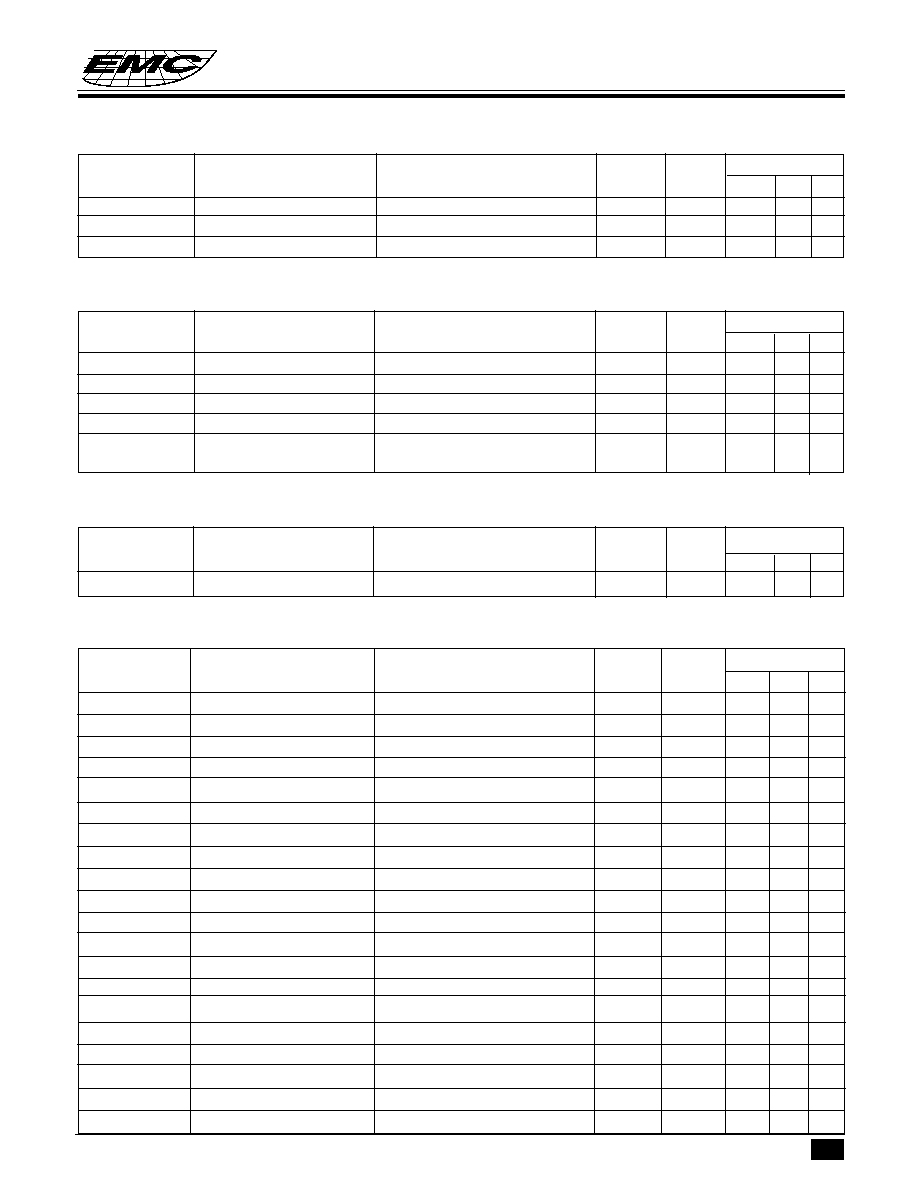
40
* This specification are subject to be changed without notice.
EM73982
EM73982
EM73982
EM73982
EM73982
4-BIT MICROCONTROLLER
4-BIT MICROCONTROLLER
4-BIT MICROCONTROLLER
4-BIT MICROCONTROLLER
4-BIT MICROCONTROLLER
11.30.2001
Mnemonic Object code ( binary )
Mnemonic Object code ( binary )
Mnemonic Object code ( binary )
Mnemonic Object code ( binary )
Mnemonic Object code ( binary )
Operation description
Operation description
Operation description
Operation description
Operation description
Byte
Byte
Byte
Byte
Byte
Cycle
Cycle
Cycle
Cycle
Cycle Flag
Flag
Flag
Flag
Flag
C
C
C
C
C
Z
Z
Z
Z
Z
S
S
S
S
S
TFCFC
0101 0011
SF
CF', CF
0
1
1
0
-
*
TTCFS
0101 0010
SF
CF, CF
1
1
1
1
-
*
TZS
0101 1011
SF
ZF
1
1
-
-
*
(12) Interrupt control
(12) Interrupt control
(12) Interrupt control
(12) Interrupt control
(12) Interrupt control
Mnemonic Object code ( binary )
Mnemonic Object code ( binary )
Mnemonic Object code ( binary )
Mnemonic Object code ( binary )
Mnemonic Object code ( binary )
Operation description
Operation description
Operation description
Operation description
Operation description
Byte
Byte
Byte
Byte
Byte
Cycle
Cycle
Cycle
Cycle
Cycle
Flag
Flag
Flag
Flag
Flag
C
C
C
C
C
Z
Z
Z
Z
Z
S
S
S
S
S
CIL r
0110 0011 11rr rrrr
IL
IL & r
2
2
-
-
1
DICIL r
0110 0011 10rr rrrr
EIF
0,IL
IL&r
2
2
-
-
1
EICIL r
0110 0011 01rr rrrr
EIF
1,IL
IL&r
2
2
-
-
1
EXAE
0111 0101
MASK
Acc
1
1
-
-
1
RTI
0100 1101
SP
SP+1,FLAG.PC
1
2
*
*
*
STACK[SP],EIF
1
(13) CPU control
(13) CPU control
(13) CPU control
(13) CPU control
(13) CPU control
Mnemonic Object code ( binary )
Mnemonic Object code ( binary )
Mnemonic Object code ( binary )
Mnemonic Object code ( binary )
Mnemonic Object code ( binary )
Operation description
Operation description
Operation description
Operation description
Operation description
Byte
Byte
Byte
Byte
Byte
Cycle
Cycle
Cycle
Cycle
Cycle
Flag
Flag
Flag
Flag
Flag
C
C
C
C
C
Z
Z
Z
Z
Z
S
S
S
S
S
NOP
0101 0110
no operation
1
1
-
-
-
(14) Timer/Counter & Data pointer & Stack pointer control
(14) Timer/Counter & Data pointer & Stack pointer control
(14) Timer/Counter & Data pointer & Stack pointer control
(14) Timer/Counter & Data pointer & Stack pointer control
(14) Timer/Counter & Data pointer & Stack pointer control
Mnemonic Object code ( binary )
Mnemonic Object code ( binary )
Mnemonic Object code ( binary )
Mnemonic Object code ( binary )
Mnemonic Object code ( binary )
Operation description
Operation description
Operation description
Operation description
Operation description
Byte
Byte
Byte
Byte
Byte
Cycle
Cycle
Cycle
Cycle
Cycle
Flag
Flag
Flag
Flag
Flag
C
C
C
C
C
Z
Z
Z
Z
Z
S
S
S
S
S
LDADPL
0110 1010 1111 1100
Acc
[DP]
L
2
2
-
Z
1
LDADPM
0110 1010 1111 1101
Acc
[DP]
M
2
2
-
Z
1
LDADPH
0110 1010 1111 1110
Acc
[DP]
H
2
2
-
Z
1
LDASP
0110 1010 1111 1111
Acc
SP
2
2
-
Z
1
LDATAL
0110 1010 1111 0100
Acc
[TA]
L
2
2
-
Z
1
LDATAM
0110 1010 1111 0101 Acc
[TA]
M
2
2
-
Z
1
LDATAH
0110 1010 1111 0110 Acc
[TA]
H
2
2
-
Z
1
LDATBL
0110 1010 1111 1000
Acc
[TB]
L
2
2
-
Z
1
LDATBM
0110 1010 1111 1001
Acc
[TB]
M
2
2
-
Z
1
LDATBH
0110 1010 1111 1010
Acc
[TB]
H
2
2
-
Z
1
STADPL
0110 1001 1111 1100
[DP]
L
Acc
2
2
-
-
1
STADPM
0110 1001 1111 1101
[DP]
M
Acc
2
2
-
-
1
STADPH
0110 1001 1111 1110
[DP]
H
Acc
2
2
-
-
1
STASP
0110 1001 1111 1111
SP
Acc
2
2
-
-
1
STATAL
0110 1001 1111 0100
[TA]
L
Acc
2
2
-
-
1
STATAM
0110 1001 1111 0101
[TA]
M
Acc
2
2
-
-
1
STATAH
0110 1001 1111 0110
[TA]
H
Acc
2
2
-
-
1
STATBL
0110 1001 1111 1000
[ TB]
L
Acc
2
2
-
-
1
STATBM
0110 1001 1111 1001
[TB]
M
Acc
2
2
-
-
1
STATBH
0110 1001 1111 1010
[TB]
H
Acc
2
2
-
-
1
(11) Flag manipulation
(11) Flag manipulation
(11) Flag manipulation
(11) Flag manipulation
(11) Flag manipulation

41
* This specification are subject to be changed without notice.
EM73982
EM73982
EM73982
EM73982
EM73982
4-BIT MICROCONTROLLER
4-BIT MICROCONTROLLER
4-BIT MICROCONTROLLER
4-BIT MICROCONTROLLER
4-BIT MICROCONTROLLER
11.30.2001
**** SYMBOL DESCRIPTION
**** SYMBOL DESCRIPTION
**** SYMBOL DESCRIPTION
**** SYMBOL DESCRIPTION
**** SYMBOL DESCRIPTION
Symbol
Symbol
Symbol
Symbol
Symbol
Description
Description
Description
Description
Description
Symbol
Symbol
Symbol
Symbol
Symbol
Description
Description
Description
Description
Description
HR
H register
LR
L register
PC
Program counter
DP
Data pointer
SP
Stack pointer
STACK[SP]
Stack specified by SP
A
CC
Accumulator
FLAG
All flags
CF
Carry flag
ZF
Zero flag
SF
Status flag
EI
Enable interrupt register
IL
Interrupt latch
MASK
Interrupt mask
PORT[p]
Port ( address : p )
Timer/counter A
Timer/counter B
RAM[HL]
Data memory (address : HL)
RAM[x]
Data memory (address : x )
ROM[DP]
L
Low 4-bit of program memory
ROM[DP]
H
High 4-bit of program memory
[DP]
L
Low 4-bit of data pointer register
[DP]
M
Middle 4-bit of data pointer register
[DP]
H
High 4-bit of data pointer register
[TA]
L
([TB]
L
)
Low 4-bit of timer/counter A
[TA]
M
([TB]
M
)
Middle 4-bit of timer/counter A
(timer/counter B) register
(timer/counter B) register
[TA]
H
([TB]
H
)
High 4-bit of timer/counter A
LR
1
-0
Contents of bit assigned by bit
(timer/counter B) register
1 to 0 of LR
LR
3-2
Bit 3 to 2 of LR
a
5-0
Bit 5 to 0 of destination address for
branch instruction
PC
12-6
Bit 12 to 6 of program counter
Transfer
Exchange
+
Addition
-
Substraction
&
Logic AND
Logic OR
^
Logic XOR
Inverse operation
.
Concatenation
#k
4-bit immediate data
x
8-bit RAM address
y
4-bit zero-page address
p
4-bit or 5-bit port address
b
Bit address
r
6-bit interrupt latch
- -








































